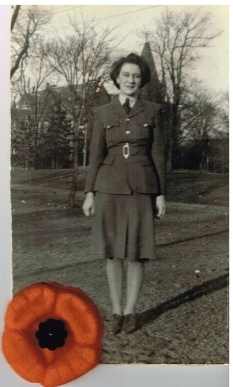Arlene Stafford-Wilson's Blog, page 37
December 1, 2021
Lake 88 Interview
A recording of the interview as host, Lynda D’Aoust, discussed my latest book, “Lanark County Comfort: Homespun Tales to Warm Your Heart”
Interviews on Lake 88

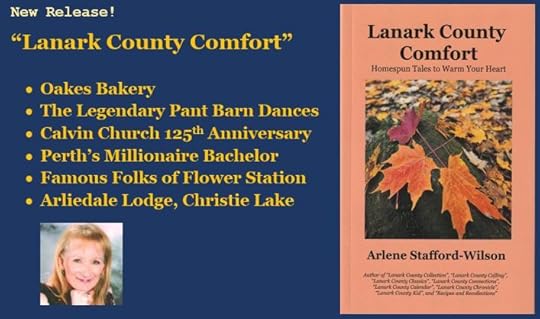
The book is available at:
The Book Nook & Other Treasures, 60 Gore St. E., Perth, ON 613-267-2350
Spark Books and Curios (formerly The Bookworm) at 76 Foster St., Perth, ON 613-264-7257
Mill Street Books, 52 Mill Street, Almonte, ON 613-256-9090
and online:

November 26, 2021
Henderson Mansion, Perth
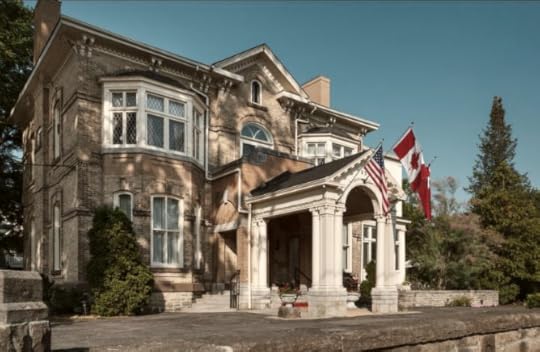
Henderson Mansion – Thuresson Place (Perth Manor)

Thuresson Place – back garden
The Henderson Mansion, also known as Thuresson Place, Perth Manor Nursing Home, and The Perth Manor Boutique Hotel, has a history dating back to the late 1800s.
1878 Henderson Family
Jesse Thomas ‘J.T.’ Henderson, was the son of Jesse Henderson and Susan Eliza Thuresson. J.T.s father was a successful merchant in Belleville, and J.T. moved to Perth in 1859 to try his luck in business. At age 25, he married Elizabeth ‘Eliza’ Wordie, and they had four daughters: Florence Wordie Henderson (1867-1949), Jessie Mabel Henderson Stewart (1868-1956), Ethel Henderson Whyte (1871-1939), and Isabel Henderson Wilson (1875-1941)
J.T. Henderson had a natural talent for business and set up several different enterprises in Perth, and generated enormous wealth for himself and his family.

J.T. Henderson, grew his business and became one of the most successful Perth merchants of that time. He built a fine home at 23 Drummond Street in 1878 at a cost of 12,000 pounds.
“He named the home, “Thuresson P
lace”, in honor of his mother.”
Thuresson Place
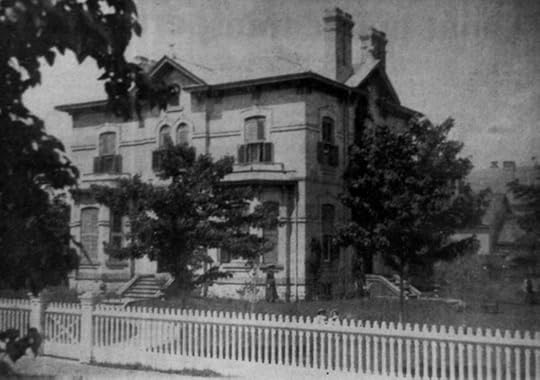
Thuresson Place – named for Susan Eliza Thuresson Henderson
“For thirty-five years, up to the time of his death, he was one of our prominent and successful merchants, honorable and generous in his dealings with the public.”

Jessie Henderson
Although the family was quite well off, and their was no economic reason for her to work, the second eldest daughter, Jessie, became an insurance agent in 1895. It was very unusual at this time for a woman to work outside the home, particularly in this type of business.
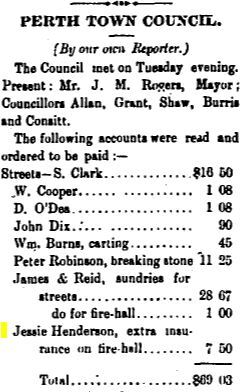
Nov. 15, 1895, p. 1, “The Perth Courier”
Jessie Married John A. ‘Jack’ Stewart
Perhaps it was her intelligence, business sense, and self-confidence that attracted one of Perth’s most eligible bachelors, Jack Stewart, to court Jessie. Jack was a successful lawyer, served two terms as Mayor of Perth, and also became a Member of Parliament. Jack and Jessie were married in 1907.
“After the marriage ceremony the wedding party returned to the home of the bride’s mother on Drummond Street where a dainty wedding dinner was served.”
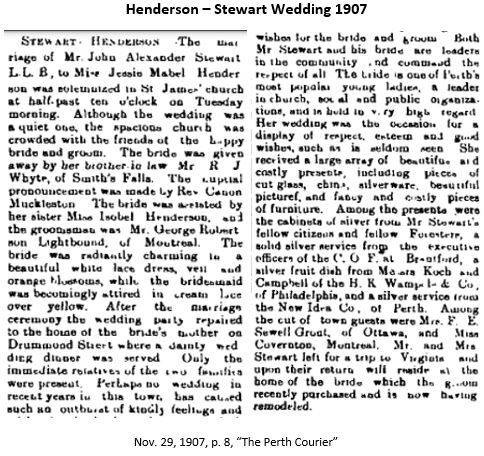
“Mr. and Mrs. Stewart left for a trip to Virginia and upon their return will reside at the home of the bride which the groom recently purchased and is now having remodeled.”
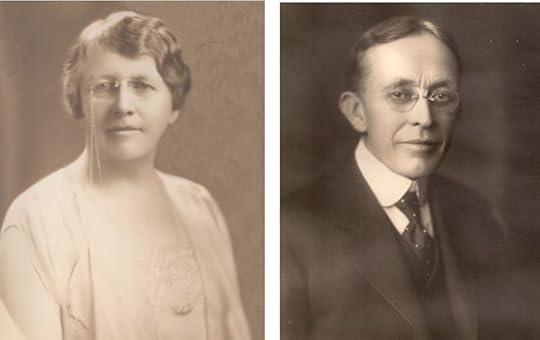
Jessie Henderson Stewart and Jack Stewart
Life with the Henderson-Stewart family:
Jessie and Jack had an upstairs maid, a downstairs maid, and a cook. They also had a butler, a nurse for Jessie’s mother, a chauffeur and a housekeeper who came once a week to polish the silver. They also employed two gardeners who looked after the property.
Jessie’s Gift to Perth
After Jack’s death, Jessie Mabel Stewart, generously gifted the 10-acre park named ‘Stewart Park’,in memory of her late husband in 1947. In 1948 Jessie gave the the Board of Education of the Town of Perth eleven acres of land for the purpose of building a new Public School, which now is known as ‘The Stewart School’.
Jessie was also a Life Director of the Great War Memorial Hospital of Perth District, Honorary President of the Women’s Hospital Aid Association, Honorary President of the Perth Museum, and District Commissioner of the Girl Guides.
O.B.E. Order of the British Empire
In recognition of her public service, Jessie was awarded the Order of the British Empire,on June 29, 1935.
Jessie died in 1956 in her 88th year at her home at 23 Drummond St., Thuresson Place.
Sabiston Family
It’s been said that Eric Sabiston was like a son to Jessie Henderson Stewart, and so, when she passed in 1956, he was given ‘first right of refusal’ to purchase Thuresson Place at 23 Drummond Street.
Eric Moorehouse Sabiston (1897-1988) was the son of Alexander Sabiston (1858-1900) and Henrietta Moorehouse (1864-1952). He married Eleanor Maitland Pollock, in 1945, and they had three children: Elizabeth, Peter, and Cynthia.
Previously, he and their family were residing at 6 Alexander Street, in Perth. Eric, the President and CEO of the Brown Shoe Company, and his family, spent many happy years at their new Drummond Street home..
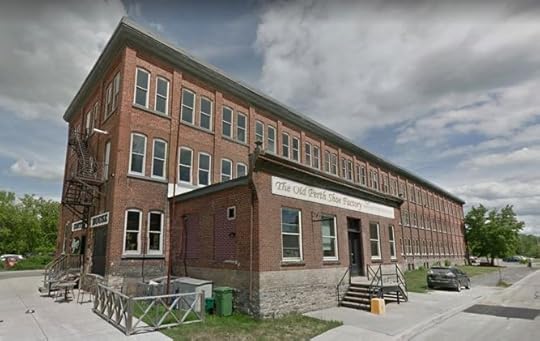
The Brown Shoe Co. in Perth, ON, where Eric Sabiston was President and C.E.O.
Eleanor Sabiston was very active with the I.O.D.E. (Imperial Order of the Daughters of the Empire), and hosted many garden parties on the spacious lawns of their Drummond St. home.

1957 I.O.D.E. Garden Party, at the Sabiston’s home. (photo: Perth Remembered)
Children: L to R: Demi Thompson, Nancy Girdwood, Elizabeth Sabiston, Peter Sabiston, Nancy Kelly, Richard Kelly, Johnny Stephens, Ann Stephens, Judy Easton, Denise Vallely
The Sabiston family sold their 23 Drummond Street home in the early 1970s, and in 1972, Catherine Doornberg converted the property to a long-term care facility, known as the Perth Manor Nursing Home.
Doornberg family
Perth Manor
Nursing Home
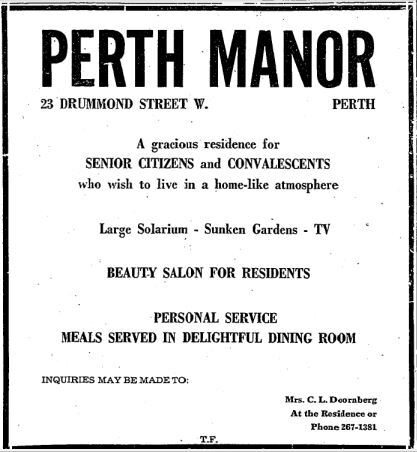
September 21, 1972, p. 15, “The Perth Courier”
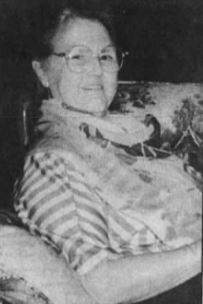
Catherine Doornberg, Owner of Perth Manor Nursing Home, photo: “Ottawa Citizen”
Catherine ‘Kay’ Doornberg was the daughter of Lt. Col. Edward Williams and Ethel May Lawrence, and mother of Helen, Ruth, Judith, Georgia, and Suzanne. Kay operated a number of nursing homes during her career, in Ottawa, Oxford Mills, Perth, and Carleton Place.

May 9, 1974, p. 7 “The Perth Courier”
Aston Family
Perth Manor
Retirement Home
In 1980, Phil Aston (1936-2015), and his wife, Gisela Krueger Aston, purchased the Perth Manor Retirement Home. They made improvements to the garden, and repaired the walls around the property. Phil was the son of James Philip Aston and Hilda Tyldum Aston. They had four children: Janet, Kimberley, David and James.

Oct. 27, 1982, p. 26, “The Perth Courier”
Phil was active in local matters, and in 1982, he ran for Town Council, along with Gerry McInnis, Dave Crowley, Orville Buchanan, William Armstrong, Jack Parsons, and John McLenaghan.
He went on to serve as a Town Councillor, and was Chair of the Perth Hospital Board. As well as owning the Perth Manor, he also owned Elmwood Lodge, in Ottawa.
Tragedy struck in the fall of 1987, when one of the residents was injured due to smoking, and later passed away at the hospital.

Nov. 11, 1987, p. 1, “The Perth Courier”
In the fall of 1988, local entrepreneur, Brian Carter proposed the construction of a four-storey, 115 bed, 85 suite retirement home on the site of the Perth Manor.
“Opponents say the development is too large, would ruin the heritage character of the street.”
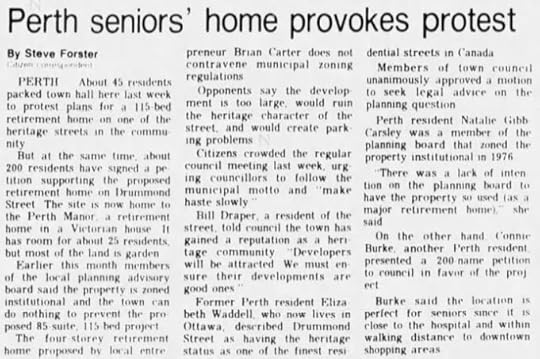
Oct. 17, 1988, p. 8 “The Ottawa Citizen”
Perth Manor
Heritage Inn
Phil and Gisela Aston closed the retirement home, and converted the nursing home into an inn.
“Phil and Gisela Aston, the owners-proprietors are a lovely, friendly couple who made us both welcome and added to our enjoyment by telling us stories of the history of the local area.”

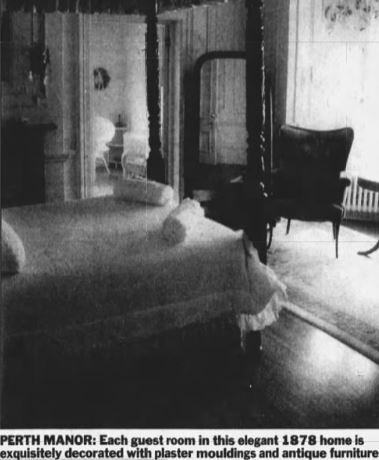
Perth Manor, as it appeared in 1996 photo: Ottawa Citizen
Dwyer and Marshall
Perth Manor
Boutique Hotel
In April 2002 The Manor was purchased by Michael Dwyer & David Marshall, both from Toronto, and were known locally as “The Manor Boyz”. It was during their time as owners that the home was modernized and ‘brought into the future’, with the addition of new technology and state of the art conveniences.

Michael Dwyer (left) and David Marshall

“The Ottawa Citizen”, Dec. 19, 2002, p. 68
Michael and David restored, renovated, and introduced the concept of ’boutique hotel’ to the Perth Manor. They also provided Event Planning for corporate and special events.
During their time as owners they installed ensuite private baths with fine linens in all guest rooms, and direct-dial phones with private voicemail. They upgraded the televisions, and installed wireless internet.
Perth Christmas
House Tour 2006
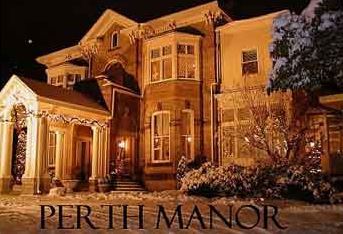
Decorated for Christmas
In 2006, the Perth Manor was featured as one of the homes in the Perth Christmas House Tour. It was the first of many historic house tours, organized by the Perth University Women’s Club, to raise money for charitable causes, and showcase the notable homes of Perth and area, decorated in Christmas splendour.
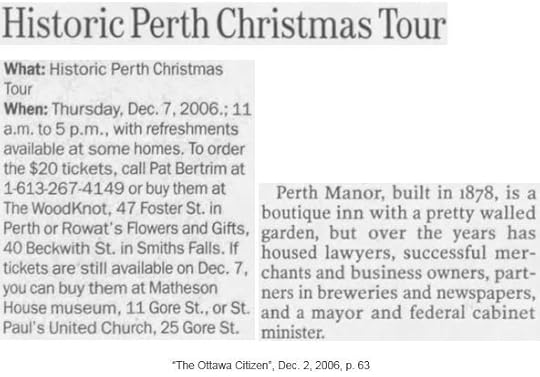
The Perth Manor was advertised for sale in 2009:

“The Ottawa Citizen”, Apr. 4, 2009, p.32
Black Tie New Year’s Party 2011
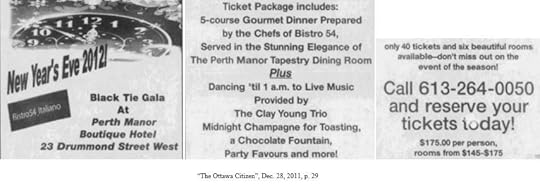
Craig family
In May, 2011, the Craig family purchased Perth Manor.

Gordon, Tyanna and Linda Craig, “The Humm” July 2021 – photo: Kris Riendeau
The Craig family members are quite musically gifted. Gordon and Linda played with the Kingston Symphony. Gordon taught in the Music department at Queen’s for over 40 years. These owners will be remembered for featuring some wonderful musical performances.
They started a chamber music series, and held jazz nights and musical dinners. They would pick a country or city, and Gordon created a fabulous six-course meal inspired by the location, along with a musical guest who played between courses. Gordon often sat in or made guest appearances with his clarinet.

Perth Manor – back garden in modern times
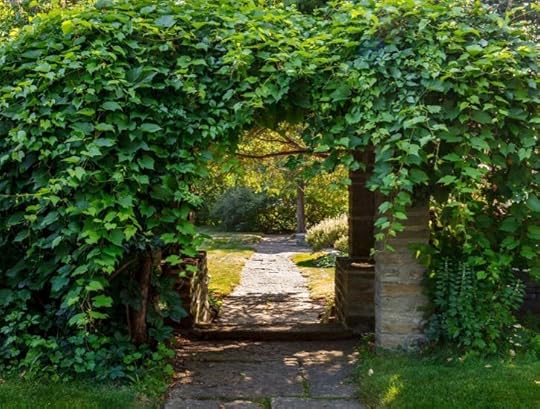
Perth Manor – garden arch
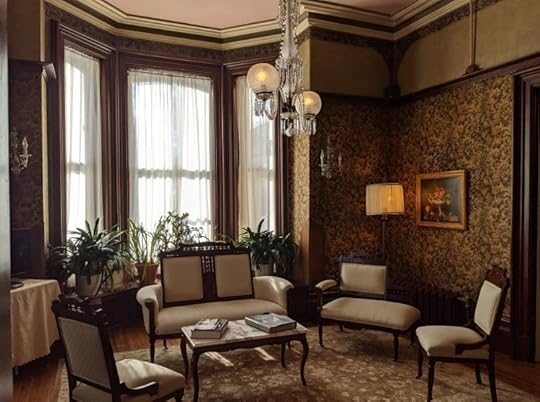
Perth Manor – sitting room

Perth Manor dining room – all ready for Christmas!
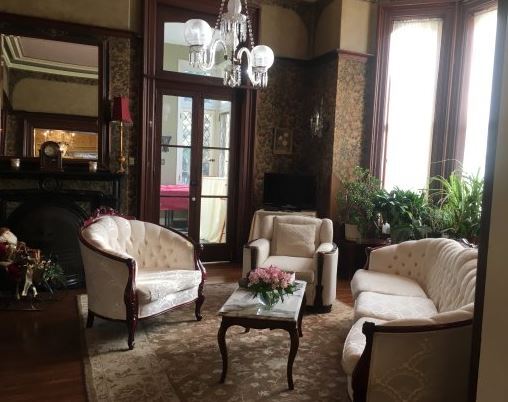
Perth Manor main floor sitting room
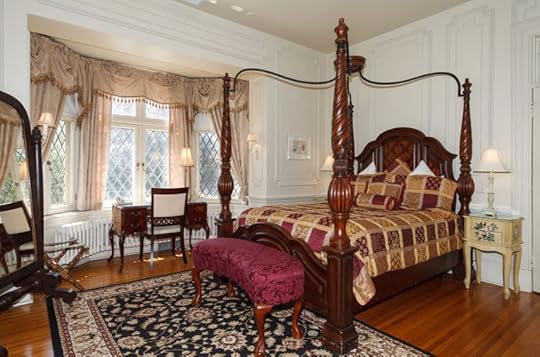
Many heritage features remain in this historic home – photo: Perth Manor website
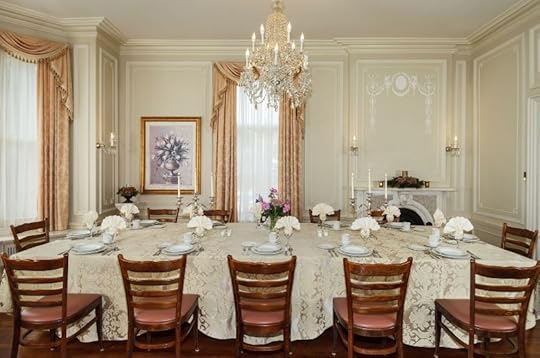
Perth Manor dining room – photo: Perth Manor website

photo: Perth Manor website
Perth Manor Closed
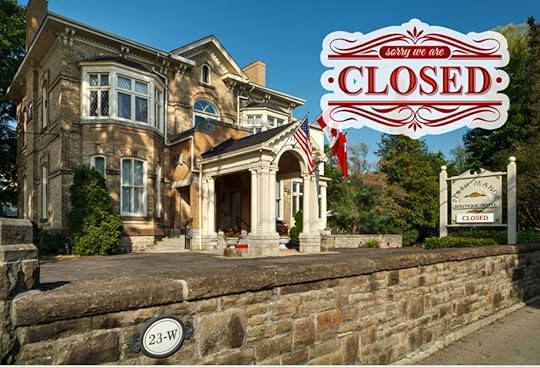
Perth Manor closed, and has been purchased to be reverted to a private residence, photo: Perth Manor website
What Does the Future Hold?
I wonder who the next lucky family will be, living at the elegant Henderson Mansion, and turning it back into a private home?
Will they stroll through the summer garden, like Jessie Henderson Stewart did, admiring the colourful perennials blooming alongside the tranquil greens and the graceful framed pathways?
Perhaps the new owners will host spectacular garden parties like Jessie and Jack Stewart, inviting the who’s-who of Perth to drink and dine in this opulent setting.
For those of us who admire this priceless monument to Perth’s storied past, we can only hope that they will pause every now and then, gaze in wonder at this beautiful place, and feel the sense of history that surrounds them, at the gracious and stately Henderson Mansion.
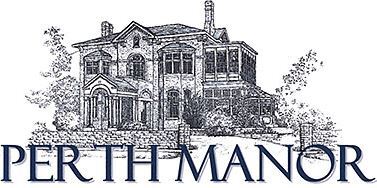
To read more about Jessie Henderson Stewart, her remarkable life at Thuresson Place, and her lasting legacy to the Town of Perth, – the story, “Jessie’s Gift”, in “Lanark County Connections: Memories Among the Maples” ISBN 9780987 702647

Available at:
The Book Nook & Other Treasures, Perth ON, Spark Books and Curios, Perth, ON,
and Mill Street Books, Almonte, ON or online:
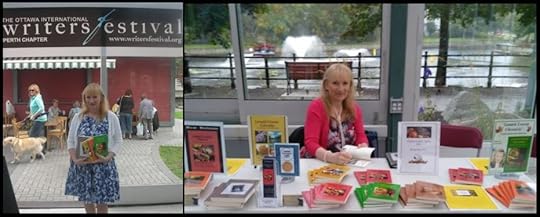
Arlene Stafford-Wilson
November 23, 2021
Pakenham Five-Span Bridge
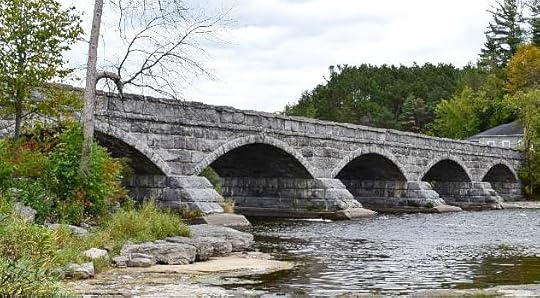
Pakenham
Five-Span Bridge
Original Bridge was Wooden
Like many other bridges in those days the original structure was built of wood, and the elements of heat and cold, freezing and thawing took their toll. The old wooden bridge needed frequent and costly repairs and it was decided that it would be a good time to construct a more durable bridge.
The Pakenham Township Counselors initially considered using iron which was popular at the time, but since the iron bridges were floored with wood they decided instead to build a stone bridge which would be longer lasting and more economical to repair. Plans were drawn for a five arch bridge, and a call for tenders was issued.

O’Toole and Keating of Ottawa
O’Toole and Keating of Ottawa won the bid, with an agreement to construct the bridge for $13,000. Ads were placed in local papers including the ‘Almonte Gazette’ and ‘The Perth Courier’ looking for bridge carpenters. They were offered an hourly wage of between $2.25 and $2.50, depending on experience, and a foremen would be hired at $3.00 per hour.
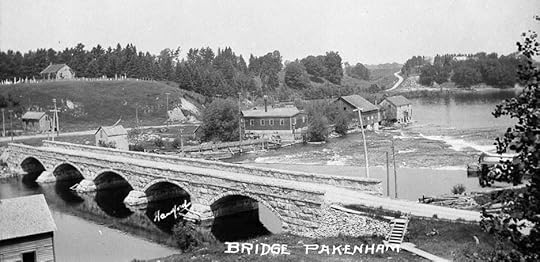
Building the Bridge
The work began on August 23, 1901 and was completed on October 23rd, an impressive seven weeks ahead of their proposed time limit. Seventy local men were employed. A steam-drill was used in the local quarry and a total of four sixty-foot mast derricks were used. It is believed that the quarry was located nearby.
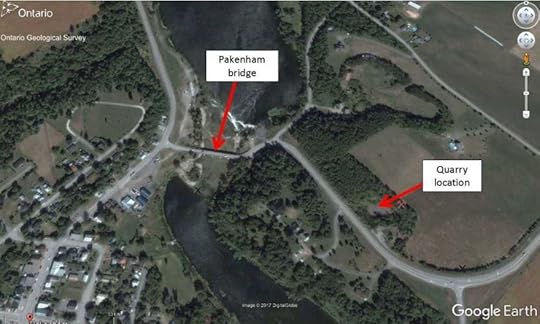
Limestone Quarry
The bridge was constructed from limestone rock. The largest limestone block in the bridge is about 9 feet long and about 2 and a half feet square, weighing over 5 tons. Limestone is an ideal material for this type of construction because it is resistant to heating and thawing, does not deteriorate when road salt is used, and is easier to mine than other similar types of rock.
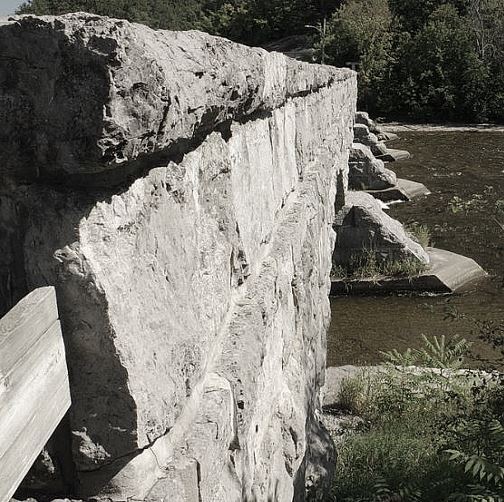
Massive limestone blocks cut from the local quarry
In the early 1900s there were an abundance of stone-cutters and mason who were skilled in cutting and shaping the limestone required for the bridge.
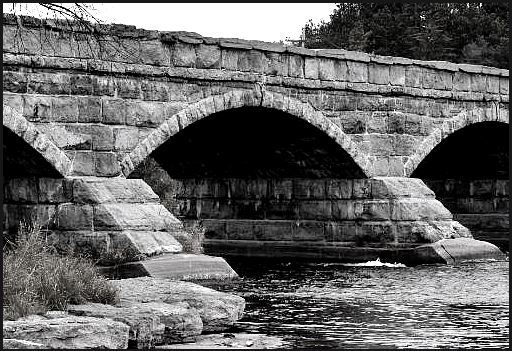
Five 40-Ft Arches
The finished bridge was 268 feet long with five forty-foot arches and was said to be the only one of its kind on the continent. James Connery, Township Clerk, John Smith – Reeve, John Shaw, Michael Connors, William Shaw and Adam Millar – Pakenham Township Councillors all played their part in the planning and execution of the new structure.

Mr. Robert Surtees of Ottawa prepared the blueprints and was the Engineer in charge of construction. William McDowall was the Inspector of the work, and Joseph Murphy of Arnprior was the book-keeper in charge of the budget while the work was in progress. George Quackenbush, local photographer, provided area newspapers with photos of the finished project.
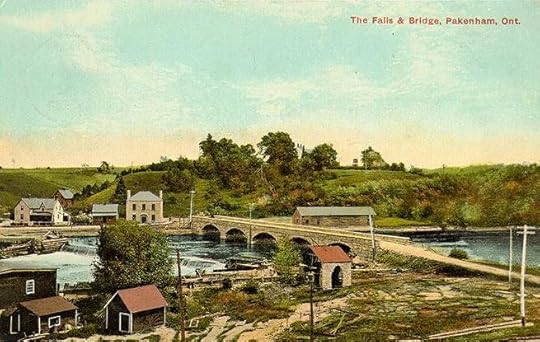
Postcard – 1910

Detail of the arch construction
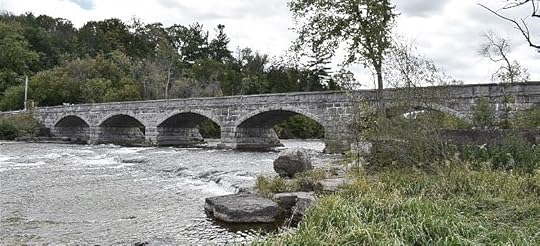
A view of the historic Pakenham bridge – the only one of its kind in Canada
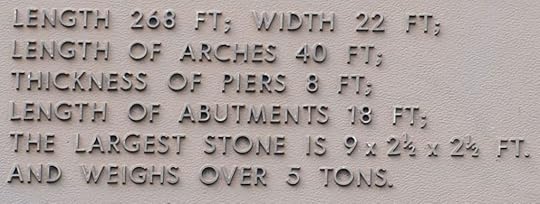
Details from the placque at the bridge site
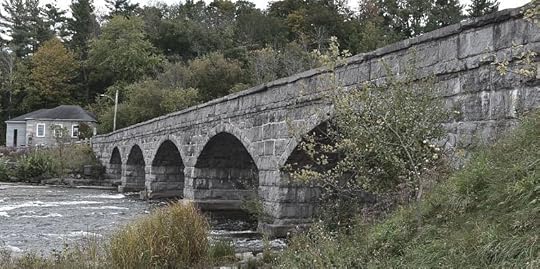
“Anyone who’s been to Pakenham will tell you that the awesome sight of this mighty river swelling and surging under the historic five-span bridge will remain forever etched in your memory. “

photo: Lanark County Tourism
Restoration in 1984

“The Almonte Gazette”


July 25, 1984, “Almonte Gazette”
The bridge was restored in 1984. The stones were carefully removed and cataloged, before being reinstated into their original position. A bed of reinforced concrete was set underneath the stones for additional strength.
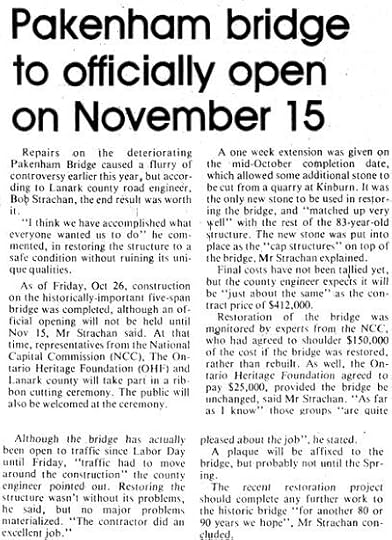
Oct. 31, 1984, “Almonte Gazette”
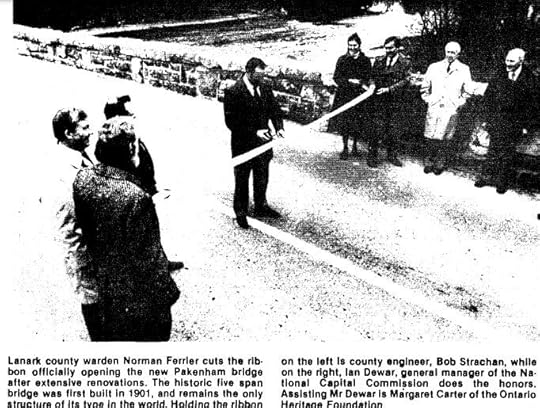
Nov. 21, 1984, p. 1 “Almonte Gazette”
Total Cost
The cost to build the bridge in 1901 was $15,400, including the construction of a temporary bridge for use during the project.
The 1984 restoration of the bridge cost $380,000. Of this, $150,000 was paid by the NCC (National Capital Commission, and $25,000 by the Ontario Heritage Foundation.
2007 Flag
Pakenham amalgamated with Almonte and Ramsay to form Mississippi Mills in 1998. The bridge was chosen as one of the principal symbols for their flag in 2007.
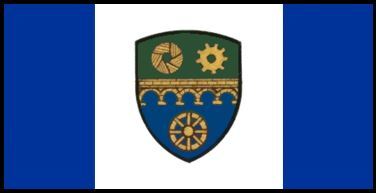
In the Movies
The 2020 Christmas movie, “Fatman”, (starring Mel Gibson, Walton Goggins and Marianne Jean-Baptiste) features a driving scene filmed on the Pakenham bridge.
Seven Wonders of Lanark County
Designated as one of the ‘Seven Wonders of Lanark County’, the Pakenham Bridge will continue to delight visitors and residents alike, with its breathtaking vistas, and rich history.
The bridge is located at 4916 Kinburn Side Road.
For a story set in Pakenham and the nearby Five-Span bridge:
“Lanark County Classics: A Treasury of Tales from Another Time – featuring the story, “Perils in Pakenham” Story features many local family names.


Arlene Stafford-Wilson
November 22, 2021
Mississippi Station & Minto Hall
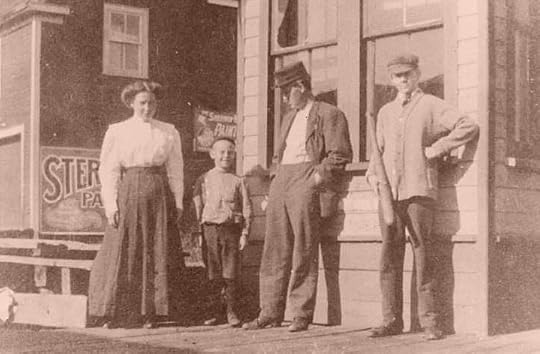
Mississippi Station and Minto Hall
Mississippi Station was one of the many stops along the Kingston and Pembroke Railway, also known as the ‘Kick and Push’. Minto Hall was built beside the train station, and became a popular venue for dances, theater performances, gatherings for church groups, and for social clubs.
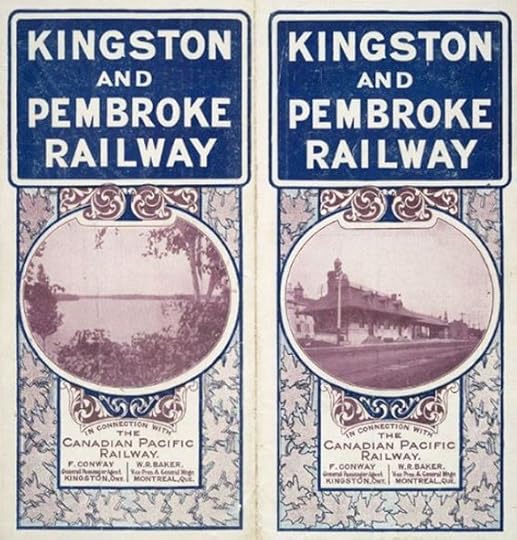
Minto Hall was built in 1898, and closed in 1961, purchased by the Department of Highways, while they were building a section of Highway 509.
Minto Hall
Minto Hall was a gathering place for people of the area for banquets, wedding receptions, for anniversary celebrations, and special church presentations. It was a popular place to hear local musicians, and see performances by local celebrities, such as the famous Marks Brothers of Christie Lake. In the early days the ground floor was used to store flour and grain, and the second floor was equipped with an auditorium, a stage, and dressing rooms.
“(In 1911) A farewell banquet was given them (Isaac Allan and family) in Minto Hall, in that village, which was attended by about three hundred and fifty people.”
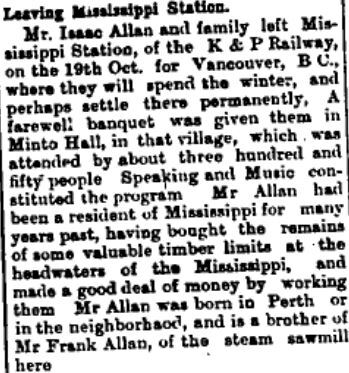
Oct. 26, 1911, “The Perth Courier”
“The dance held in Minto Hall on Christmas night was a decided success.”
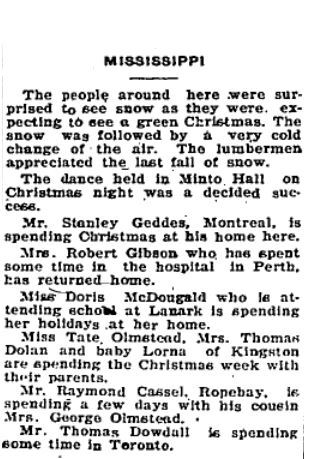
Jan. 4, 1924, p. 7, “The Perth Courier”
“Mrs. A.C. Rhodes attended the monthly meeting of the Women’s Institute in the Minto Hall, Mississippi.”

May 17, 1935, p.8 “The Perth Courier”
“Tichborne Young People’s Society presented a three-act comedy drama in Minto Hall on Friday evening to a capacity audience.”
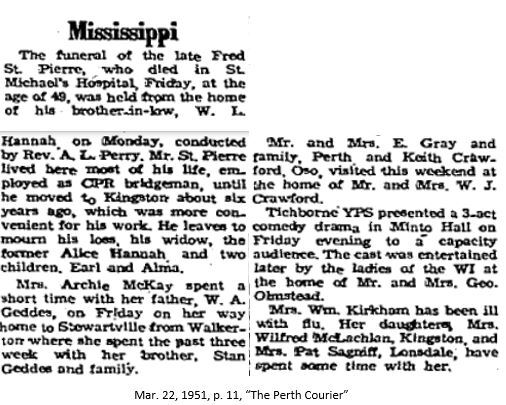
Minto Hall Sold
“It was a nostalgic day here on Monday in Mississippi Village. At 1 p.m. the final blow of the auctioneer’s gavel sold Minto Hall to the highest bidder.”
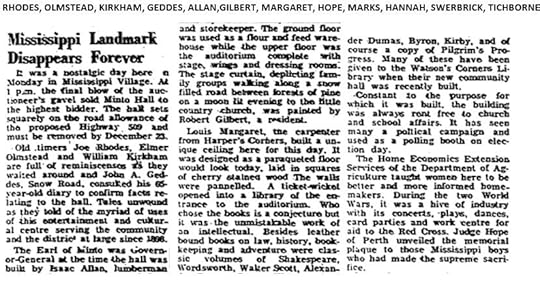

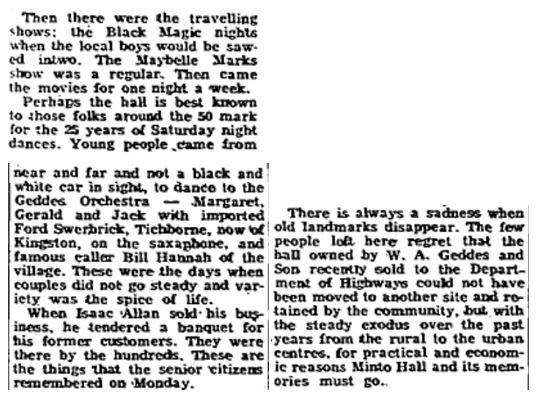
(article from Nov. 23, 1961, “The Perth Courier”)
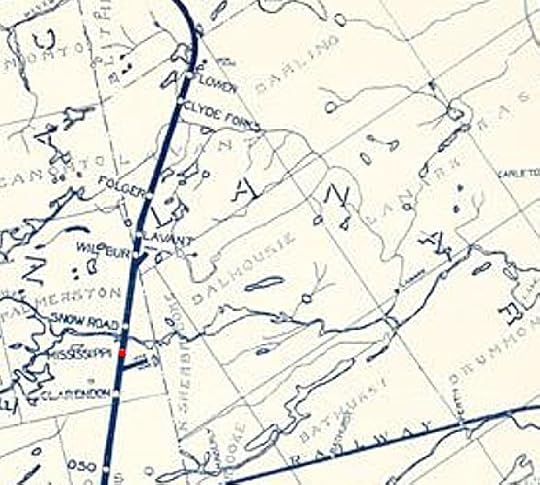
Location of Minto Hall at Mississippi Station (in red) on the K & P Raiway route
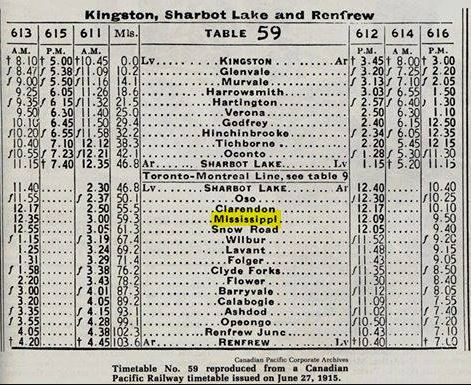
Mississippi Station timetable – 1915
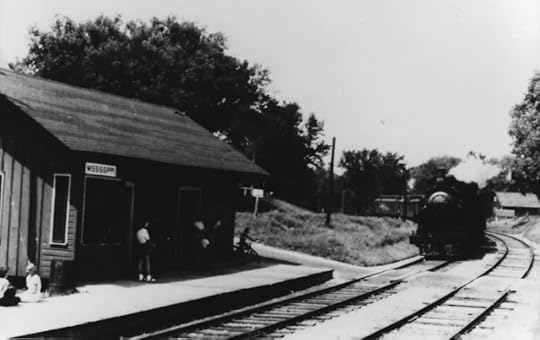
Mississippi Station – photo Harold Geddes
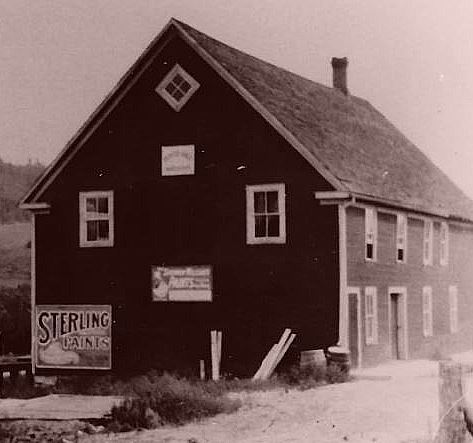
Minto Hall (1898-1961)
Sir John A. Macdonald’s Last Ride
On June 11, 1891, the K&P delivered its most famous cargo, the remains of Canada’s first prime minister, Sir John A. Macdonald, from Sharbot Lake Junction to his home in Kingston.

Queen’s University Archives, K & P Railway Locomotive, 1901
The last train
The last K & P freight train ran December 29, 1961.
The end of Minto Hall
…And so, Minto Hall was sold and demolished in the winter of 1961, to make way for the construction of this particular section of Highway 509.
The owner of the property, W.A. Geddes, regretted the necessary sale to the Department of Highways, and there were many locals at that time who had hoped that Minto Hall could have been moved to another location, and preserved as a heritage structure.
Sadly, “Minto Hall and its memories must go.”
November 18, 2021
Clyde Hall – Caldwell Mansion
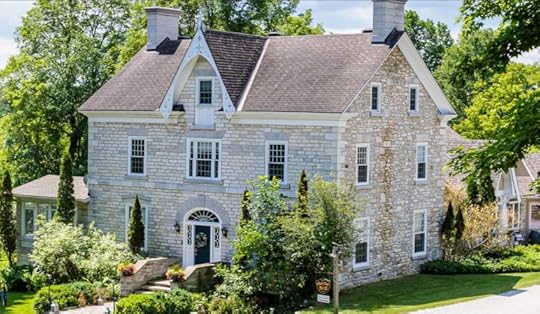
Clyde Hall
Caldwell Mansion
Caldwell Family
“They accepted the wilderness at its worst, defied it, and won.
It was a triumph of the human spirit over disaster.”
“The Caldwells of Lochwinnoch, Renfrewshire, Scotland, can be traced in direct lineage to an Alexander Caldwell, born 1636, died 1706. From this ancestor three successive generations of Alexander Caldwells carried on the family name until the auld Kirk burying ground gave them perpetuity in slabs of stone. Then came the first break when William Caldwell, son of the fourth Alexander, left the glens and braes, exchanging an Arcady for a wilderness.
William Caldwell was prospering in the Paisley shawl trade when the economic disaster, following the Napoleonic wars, blasted the weaving industry into financial ruin and drove its dependents into poverty. Then for many a family came the most difficult decision of a lifetime – to emigrate and transplant the roots of generations or to remain and suffer with kinsfolk. To their everlasting honor they did not shrink from meeting the only alternative, and this country gained thereby an infusion of that rugged independence of character which is the glory of the Scot, William Caldwell and his family were among those who accepted this challenge of destiny.
They came on the Earl of Buckinghamshire, William Caldwell, and his highland wife, Margaret McCallum, and their children, Margaret, Mary, Alexander and Boyd, who with 600 others faced a seven-weeks’ voyage under distressing conditions before setting foot on land. The limits of space preclude giving many names from the passenger list of emigrants on the Buckinghamshire, and other sailing ships, “George Canning”, “Commerce”, and “David of London”. Many of their descendants still live on the homesteads they hewed in the pioneer townships of Lanark.
Caldwell, and another emigrant, James McIlraith were members of the Paisley Townhend Emigration Society, and having drawn their location tickets from Colonel William Marshall, Superintendent of settlement at the Lanark depot, they selected their lots on either side of the Third Concession Line of Lanark Township, about seven miles northwest of the present village. They must have had an eye for something reminiscent of the glens of home for here a brawling burn known as the Little Clyde, cascades down a charming vista. Most appropriately, they called in ‘The Clachan” (small village), and it remained the motivating spirit of the Caldwell-McIlraith Settlement. Here, far from the noisy gnat-swarm of cities, they wrought out their separate destinies. They accepted the wilderness at its worst, defied it, and won. It was a triumph of the human spirit over disaster.
The Caldwells and all that gallant company started from scratch. Supplies and material were expensive and hard to procure. In summer they had to be ‘man-packed’ over the forest trails from distant centers. Their first log dwellings were chinked with moss, and their clothes were homespun. But there was an abundance of game and fish and wild fruit. They learned the first crude methods of making maple syrup and sugar, and brewed tea of herbs.”
(excerpt from an article by Harry J. Walker in “The Ottawa Journal”, March 23, 1937, p.6)
Caldwell Family
William Caldwell (1774-1863) and Margaret McCallum Caldwell (1788-1879) had ten children, six girls, and four boys: Margaret (1812-1877), Alexander (1815-1872), Mary Ann (1818-1872), Mary (1816-1852), Boyd (1818-1868), Euphemia (1821-1874), William (1822-1862), John (1825-1897), Ann (1830-?) and Agnes (1833-1907).
Clyde Hall
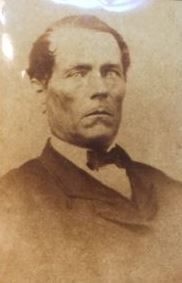
Alexander ‘Sandy’ Caldwell in 1869
Clyde Hall, the Caldwell mansion, was built in 1846 by the wealth generated from a successful lumber trade established by Alexander ‘Sandy’ Caldwell and his wife, Mary Ann Maxwell Caldwell.
Mary Ann died suddenly of a heart attack at age 54, in 1872, and her husband, ‘Sandy’ passed away three months later at age 57. (It’s been said that he never recovered from her death, and that he died from a broken heart)
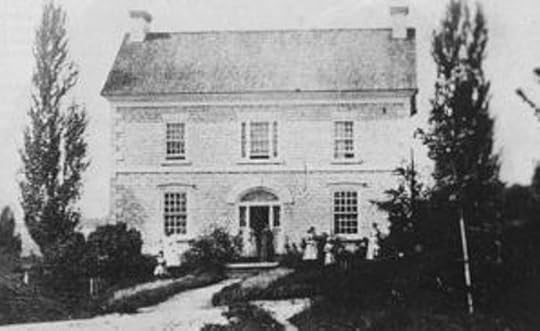
Clyde Hall in its early days
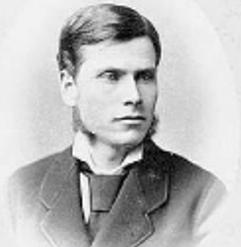
William Clyde Caldwell, son of Alexander Caldwell and Mary Maxwell Caldwell

Miss Caldwell, June 1881, taken in Ottawa, by Wm. Topley (Library & Archives Canada)
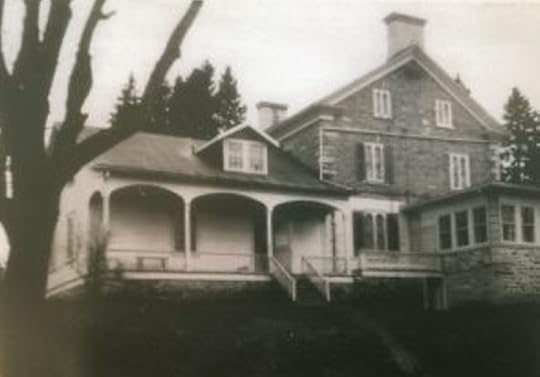
Clyde Hall with the addition of a summer kitchen c. 1889
“Mr. W.T. Traynor, chairman of the reception committee, was waiting with a beautiful sleigh drawn by four beautiful white horses, driven by Mr. James McArthur, and gaily decorated in honor of the occasion.”

“The watch was presented by Mr. W.T. Traynor, and was a beautiful specimen of the watchmaker’s art, being solid gold, 14 carat, 21 jeweled, hunting case, bearing on the outside the monogram, A.C.C., while on the inside was engraved, “Presented to Lieut. A.Clyde Caldwell, R.C.R. by his fellow citizens, on his safe return from active military service in South Africa, Lanark, Dec. 1900.”
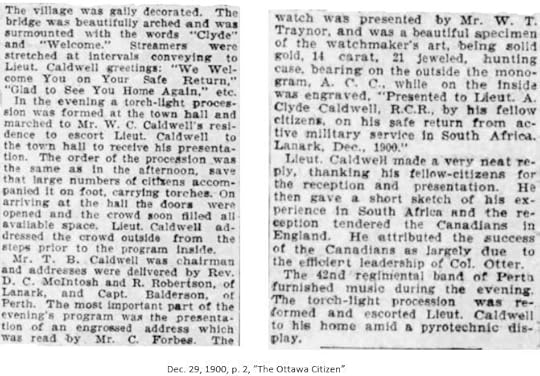
Clyde Hall estate was passed down to Thomas Boyd ‘T.B.’ Caldwell, the son of Boyd Caldwell, when he was left as “sole representative and proprietor of the Boyd Caldwell interests”, including the Caldwell Woolen Mill, lumber enterprises, mining rights, and a store in Lanark.
Thomas Boyd Caldwell, known as “T.B.” Caldwell, was a Member of Parliament for North Lanark, under Wilfred Laurier,
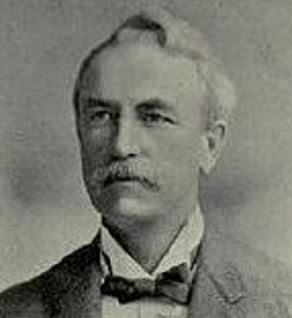
Thomas Boyd ‘T.B.’ Caldwell, M.P. for Lanark North, (1856-1932), was the last of the Caldwell family to own Clyde Hall
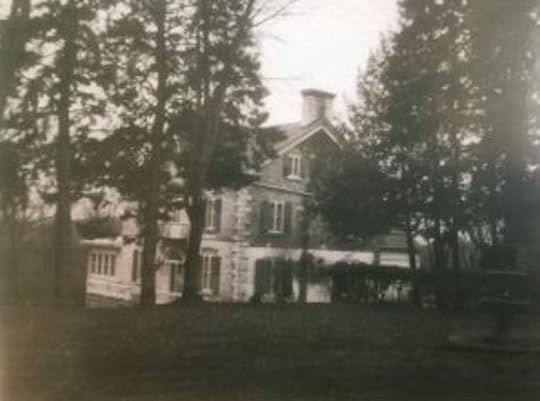
Clyde Hall c. 1900

April 9, 1908, p. 10, “The Ottawa Journal”
Clyde Hall – Legacy of the Caldwell Family
“In Lanark village, the old Alexander Caldwell house, known as ‘Clyde Hall’, remained in the family for nearly a century.”
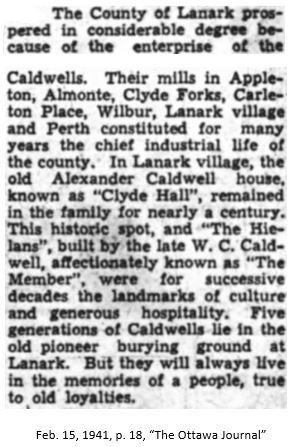
Clyde Hall remained in the Caldwell family until the summer of 1932, following T.B. Caldwell’s death, when it was sold to Mr. M.J. Cullen.
Cullen family
M.J. Cullen was the Chief Immigration Inspector of the Dominion, for three terms, and private secretary to the Hon. Wesley Gordon, Minister of Immigration.
Michael Joseph Cullen (1884-1951) married Mary Louise ‘Minnie’ Nagle, (1877-1952) in Carleton Place, in 1907. Their children: John Arthur Cullen (1911-1992), Muriel Cullen Macdonald (1913-1992), Kathleen Cullen Macdonald (1915-1991), Dorothy Cullen Burnett (1916-2005), Frances Cullen (1916-1919), Helen Cullen McCormick (1920-1975), and Mary Cullen Meagher (1929-2011)
When the Cullen family bought Clyde Hall, Michael was 48, his wife, Minnie, was 45. Their children: John was 21, Muriel was 19, Kathleen was 17, Dorothy was 16, Helen was 12, and Mary was 3.
“Mr. M.J. Cullen has recently bought from the T.B. Caldwell estate, the fine old residence known as ‘Clyde Hall’, in Lanark Village.”
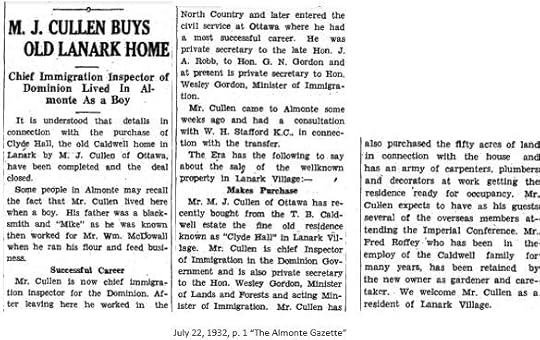
The Cullen family enjoyed Clyde Hall as their summer home, and many upgrades were completed while they owned the property. They retained one of the Caldwell employees, Mr. Fred Roffey, as their gardener and caretaker.
The Cullen family remained at Clyde Hall for six years, then in 1938, they sold the property to Ottawa businessman, Herbert Plant and his family.
Clyde Hall Sold
to Herbert Plant
“Mr Plant, a brother of a former Mayor of Ottawa, and prominent businessman, intends further to improve the property.”
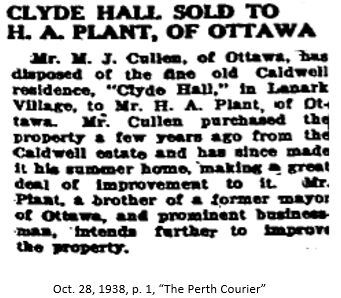
Plant family
In the fall of 1938, M.J. Cullen sold the property to Herbert A. Plant, (1893-1952) an Ottawa businessman. Plant was the co-founder of Plant and Anderson Limited, and in later years he was a Director of the Ottawa Rough Riders. His brother, Frank H. Plant, served as Mayor of Ottawa from 1921-1923, and again in 1930.
Clyde Hall was a summer home for Herbert Alfred Plant (1893-1972) and his wife, Gladys Lilian Robertson Plant (1895-1986), and their two children, Isabel Plant, (1922-2006), and James Plant, (1925-2018)
Gladys Plant was a member of the Imperial Order of the Daughters of the Empire (I.O.D.E.), and frequently entertained members of her club at Clyde Hall, during the summer months, when they were in residence there.
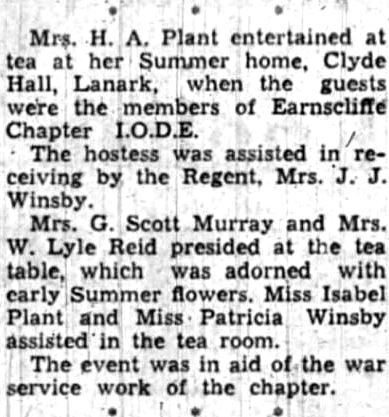
June 27, 1940, p. 10 “The Ottawa Journal”
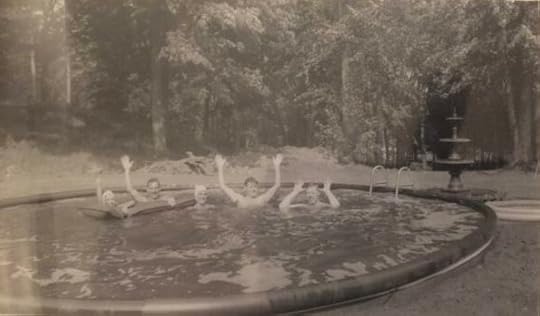
The Plant family enjoying the pool at their home, Clyde Hall, Lanark, ON
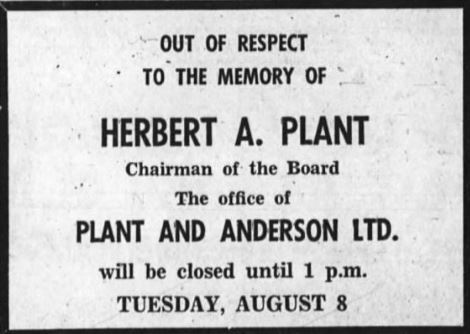
Clyde Hall For Sale
$29,500
In the fall of 1957, Clyde Hall was put on the market:
“14 spacious rooms, and 58 acres. One of the finest estates in the valley.”
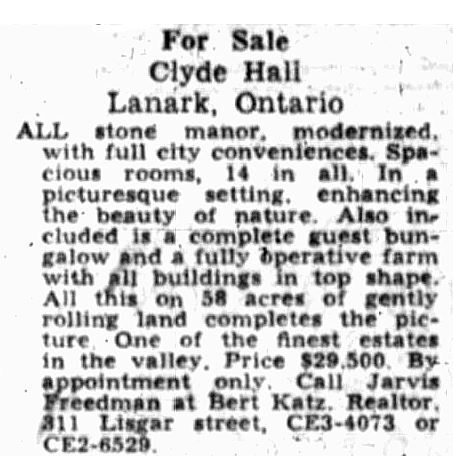
Sept. 28, 1957, p. 23, “The Ottawa Journal”
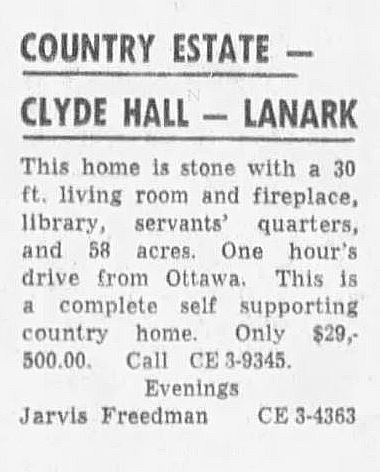
May 15, 1958, p. 26, “The Ottawa Citizen”
McMullen family
Pearl Lusk McMullen, daughter of Howard Lusk and Jessie Grant, purchased Clyde Hall in 1958, along with her son, Thomas ‘Bob’ McMullen and his wife, Jean Victoria Wilmott McMullen, and established the Clyde Hall Nursing Home.
Pearl’s grandchildren, Sharron ‘Sherri’ McMullen (Lillico), James McMullen, Gloria McDonald, Betty Ann McMullen Stanton, Robert McMullen, and Thomas McMullen spent their summers at Clyde Hall.
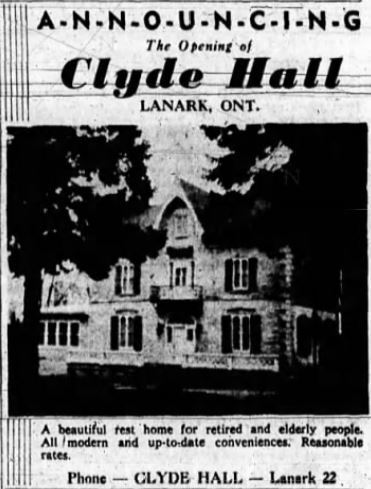
July 19, 1958, p. 7, “The Ottawa Journal”
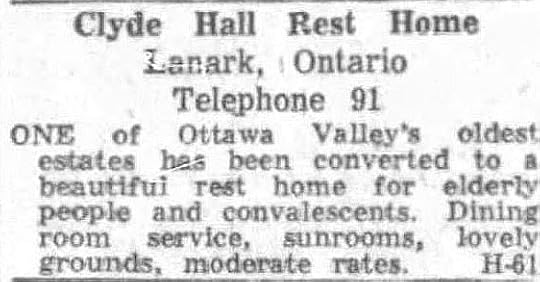
September 3, 1958, p. 35, “The Ottawa Citizen”
On March 19, 1963, Pearl McMullen, owner of the Clyde Hall Nursing Home, passed away suddenly, at age 62.
By the fall of 1963, Clyde Hall was under new management.
In 1963 – Clyde Hall Nursing Home
Under New Management
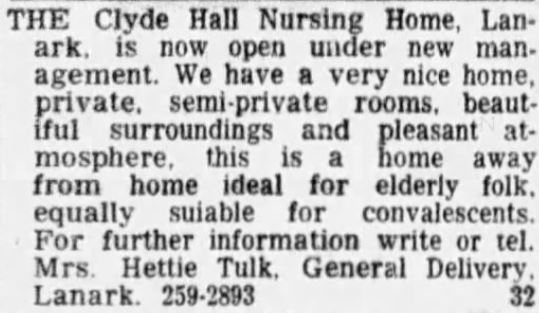
Nov. 7, 1963, p. 43, “The Ottawa Citizen”

May 23, 1964, p. 37, “The Ottawa Journal”
By the early 1970s, the structure was abandoned by the owner of the property, who lived in Toronto. The building became rundown, and vandalism and looting were rampant.
1970s – Youth Programs
& Project Echo
In the summer of 1972, a program called Opportunities for Youth was established in Lanark County. One of the projects initiated was called ‘Project Echo’, and they received a grant of $12,200, to provide a center for local youth. The owner of Clyde Hall (unknown) a resident of Toronto, kindly allowed the members of the project to use it, rent free for their drop-in center.
“They received a grant of $12,200 to provide a center for local youth.”

July 6, 1972, p. 2, “The Perth Courier”
The program ran from July – September in 1972. In the afternoons and arts and crafts program included bead-work, fabric printing, ceramics with clay, batik, and candle-making. Evening programs featured games, music and entertainment. On September 3, 1972, the program’s final event, a music festival, was held at Clyde Hall, Toronto music group, ‘Crab Shaw’, were the evening’s special guests. Local musicians were invited to play. The festival attracted between 100-200 youth.
“By the late 1970s, there were safety concerns brought to the attention of the Lanark Township Council concerning an open well on the abandoned property.”
The property remained empty, abandoned, and overgrown during the 1970s, 1980s, and 1990s.
Mysterious Fire of 1999
The fire of 1999 destroyed the interior, and left only a shell of the former glory of the once stately building. It is believed to have been caused by arson.
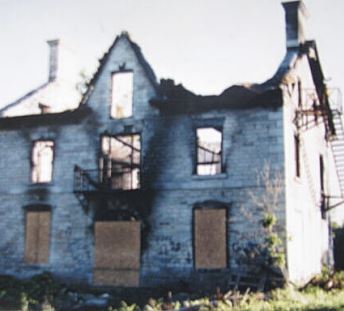
Very little remained of the beautiful historic home of the Lanark Caldwell family.
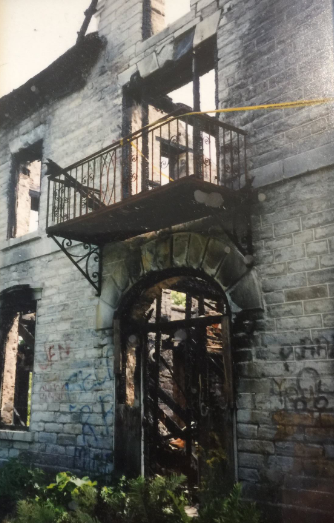
Lillico family

In an article in by Iris Winston, in “The Ottawa Citizen”, Oct. 4, 2003, p. 81:
“As a teenager, Mrs. Lillico had spent her summers helping at the retirement home that her grandmother, Pearl McMullen, operated out of Clyde Hall. The house, together with the 300 acres around it, was eventually purchased by Ms. McMullen in 1958. After her sudden death five years later, ownership reverted to the Toronto businessman who held the mortgage on the property.
Mrs. Lillico made several unsuccessful attempts to buy the house from him. Disheartened, she recognized that she must let her dream go.
In 1999, Mrs. Lillico discovered that her grandmother’s property had been purchased by a local developer, who intended to use most of the land for a golf course. He was also ready to sever the house and 10 acres around it from the golf course development. The news rekindled Mrs. Lillico’s dream to own the property.
Although the interior had been gutted (by the fire of 1999), and the roof had caved in, the two-foot-thick stone walls remained intact. So did Mrs. Lillico’s passion for the house. By January 2001, it was the Lillicos’ new home.
Rebuilding and recreating Clyde Hall in the image of the original with the added conveniences of modern plumbing and kitchen facilities was an 18-month undertaking.
Mr. Lillico recalled, “..We made sure that reconstruction was identical to the way it was in 1870. The beams are the same size, hooked into the stone in the same way. The timbers are extra heavy and extra-large. We had to use a manual lift to put them in place in each floor.”
Eaves and decorative overhangs were customized to replicate the originals. The banister and a few of the wooden spindles below it had survived the fire. Replicas were made to complete the reconstruction of the staircase.
It took some time to find a tradesman willing to tackle the complex job, until Michael Miller, an enterprising fellow from Carleton Place accepted the challenge.
The whole project, from purchase through renovations has cost the couple about $700,000.”
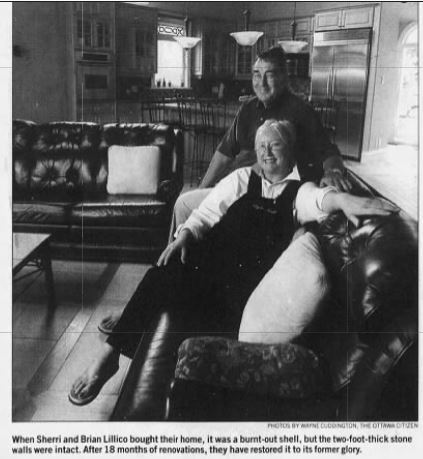
photos by Wayne Cuddington, “The Ottawa Citizen”, Oct. 4, 2003, p. 81
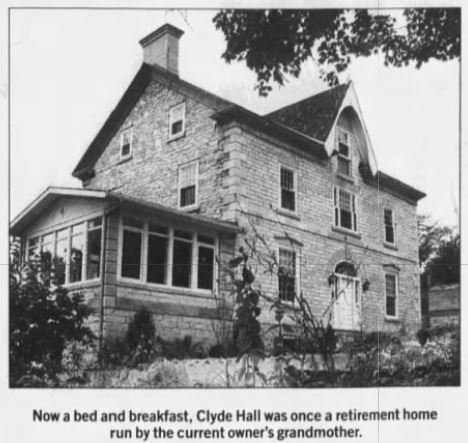
Oct. 4, 2003, p. 81 “The Ottawa Citizen”
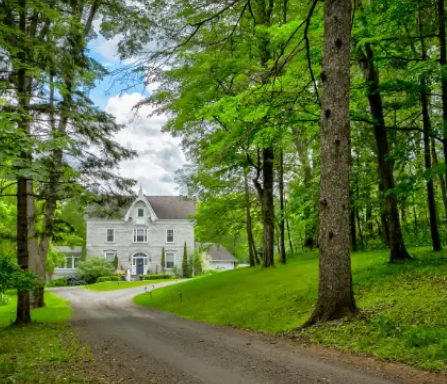
New Gates added 2011
In 2011, local Blacksmith, Tony Walsh, created new gates for Clyde Hall.
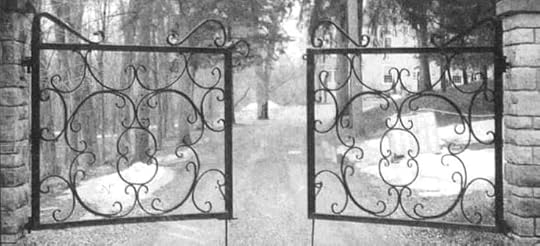
April 9, 2011, p. 39, “The Ottawa Citizen”
Salzmann Family

photo: from the Clyde Hall website – http://www.clydehall.com
In 2017 Liisa and Robert Salzmann moved from Toronto and purchased Clyde Hall. Liisa is a gourmet chef, and Robert is a certified Master Pastry Chef. He also works part time as a Professor at Algonquin College, teaching baking and pastry arts.
Clyde Hall offers High Tea, Rehearsal Party Dinners, Gift-Opening Brunches, and Wedding Cakes. They also offer courses on the art of running a bed and breakfast business.
Photos of Clyde Hall Bed and Breakfast:
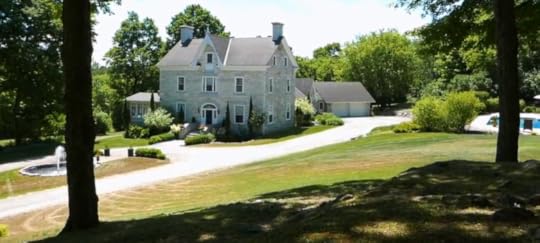
The driveway and scenic grounds of Clyde Hall as it appears today
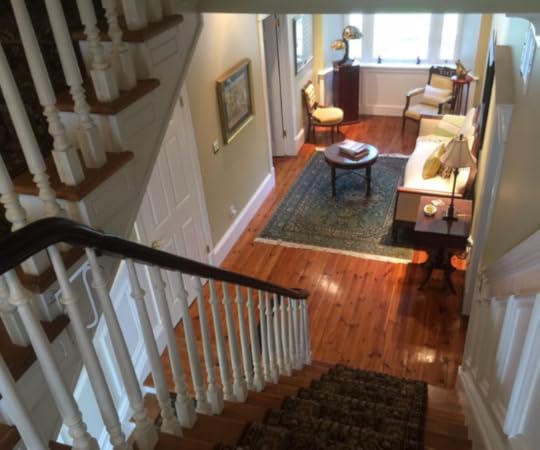
Entrance hall and staircase at Clyde Hall
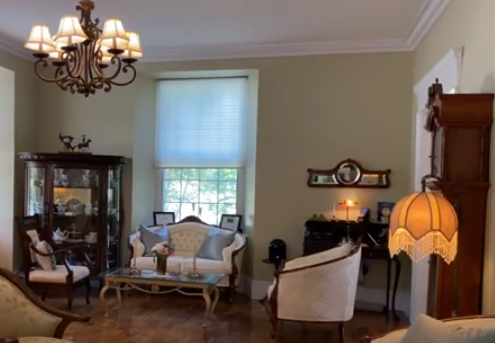
One of the elegant rooms at Clyde Hall

Clyde Hall parlor

Decorated to preserve the historical features
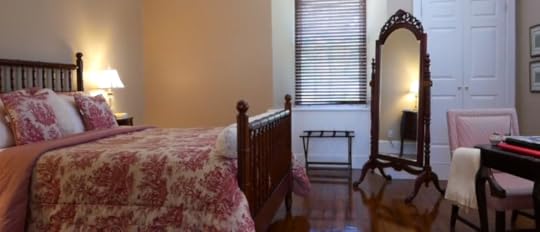
One of the bedrooms at Clyde Hall

Elegant dining at Clyde Hall (photo from the Clyde Hall website)
Clyde Hall
Past, Present, and Future
…And so, we’ve witnessed the evolution of Clyde Hall, from its proud beginnings as the mansion of the wealthy Caldwell family, those hopeful sons and daughters of Scotland who came to the New World, worked hard, and found success. The Caldwell offspring continued their legacy, provided employment for many, served their communities in politics, and for them Clyde Hall became a proud symbol of their success.
The families that followed added their own special spirits to this historic home – Michael Cullen, the Chief Inspector of Immigration for the Dominion, his wife, Minnie, and their large busy brood of children, laughing and playing on the grounds. The Cullen family hosted the overseas members attending the Imperial Conference within the walls of Clyde Hall.
Next, there was Herbert A. Plant, founder of Plant and Anderson Limited, Director of the Ottawa Rough Riders whose brother had risen to the ranks of Mayor of Ottawa, and Herbert’s wife, Gladys Plant, an elegant hostess, and their two children, Isabel and James.
Pearl Lusk McMullen came next to Clyde Hall, with her vision for a beautiful home for the aged, set among the tall trees and spacious lawns – the perfect setting for her guests to heal their bodies and their spirits. The McMullen grandchildren never forgot their idyllic summers spent at the mansion – Sherri, James, Gloria, Betty Ann, Robert, and Thomas.
Although Clyde Hall had a brief moment during the 1970s when it served the youth of the community, it may remain a mystery as to why the owner in Toronto left the property abandoned for so many years, or if the fire in 1999 was truly accidental.
Brian and Sherri Lillico, Clyde Hall’s next owners, took the burned stone shell, and pile of ashes, and through hard work and determination brought the mansion back to her former glory and beyond. Like her grandmother, Pearl, Sherri thought the magnificent home should be shared with others, and she and her husband established a bed and breakfast.
Clyde Hall’s current owners, Liisa and Robert Salzmann continue the tradition of inviting guests to their elegant country estate for rest, relaxation, fine dining, and special events. Robert, a Master Pastry Chef, and Liisa, a gourmet chef, bring the element of finely-crafted food to their inviting bed and breakfast.
As Clyde Hall evolves over the years we can only imagine what her future may hold. The estate is one of the crown jewels in Lanark’s past and present, and a monument to the proud history of the community. From a stately home for the Scottish lumber barons, to an elegant bed and breakfast fit for a king, Clyde Hall’s history, mystery, and mystique, lives on.
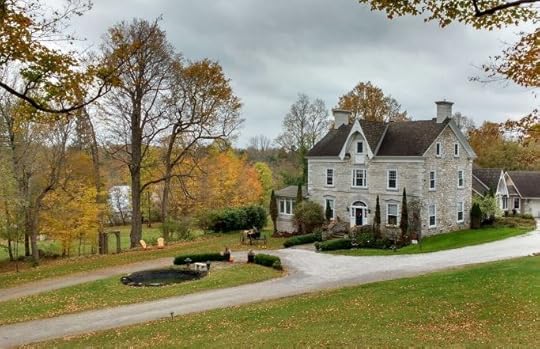
Clyde Hall is located at 131 Mill St. in beautiful Lanark, Ontario
For more information: https://www.clydehall.ca/
For more local history and stories set in Lanark County: http://www.staffordwilson.com
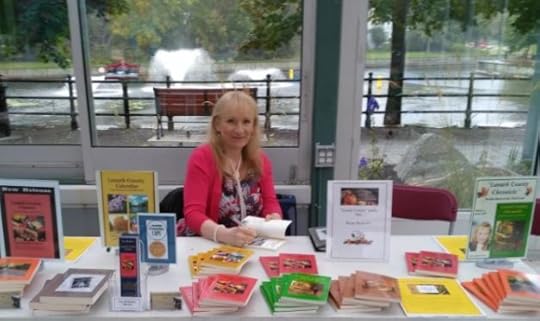
Arlene Stafford-Wilson
November 16, 2021
Scotch Line Cheese Factory
Opened in 1879
The Scotch Line Cheese Factory opened in 1879, and was established as a co-operative business, with many local farmers contributing their milk. Cheese, cheese curds, and butter were produced there, and the quality of their products had a reputation for excellence, and were in demand locally.
Some of the names of people who played an important role at the Scotch Line Cheese Factory through the years:
Abercrombie, Allen, Avery, Bowes,
Burnham, Dodds, Ferrier, Gibson,
Hough, Kellar, Mackler, McGinnis,
Noonan, Partridge, Rancier, Wiltsie
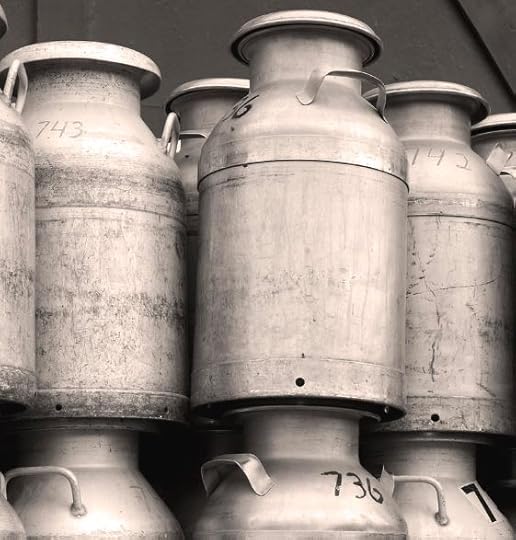
“The cheese had to be placed in the car five tiers high,
and the work was very exhaustive.”
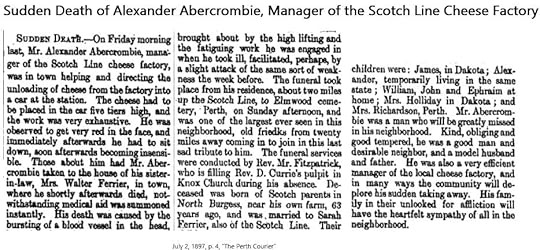
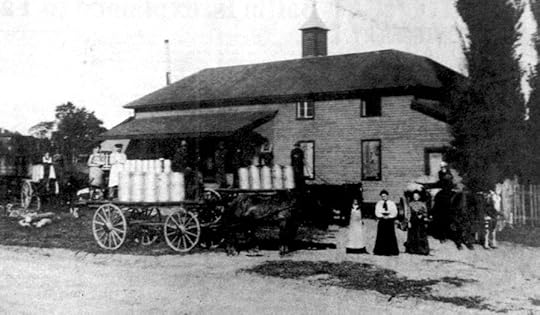
photo: Perth Remembered
Photo was taken around 1910 at the Scotch Line Cheese Factory
Ben Avery, the Cheese Maker, is in a white apron, standing beside the milk cans.
James Gibson and his nephew, John A. Gibson is on the wagon to the left side of the photo.
Sarah MacLennan and Mrs. James Allan are standing in the group of three women to the right of the photo.
December 1913 Fire
“Neighbours saved some fancy cheese the maker, Mr. Hough had, for a dairy show,
but the last day’s make of butter, about 350 lbs, was burned.”
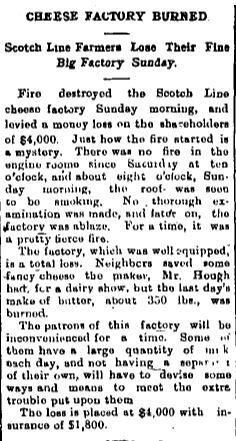
December 26, 1913, p. 1, “The Perth Courier”
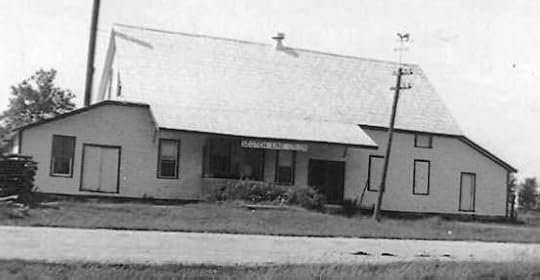
Scotch Line Cheese Factory, rebuilt, as it appeared in 1932
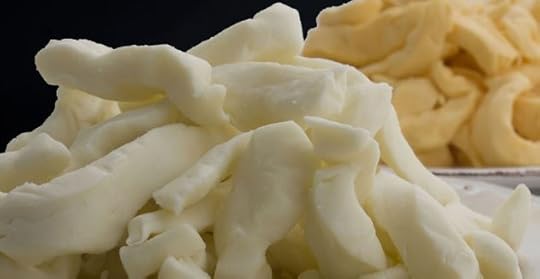
George McGinnis Retires
After 17 Years
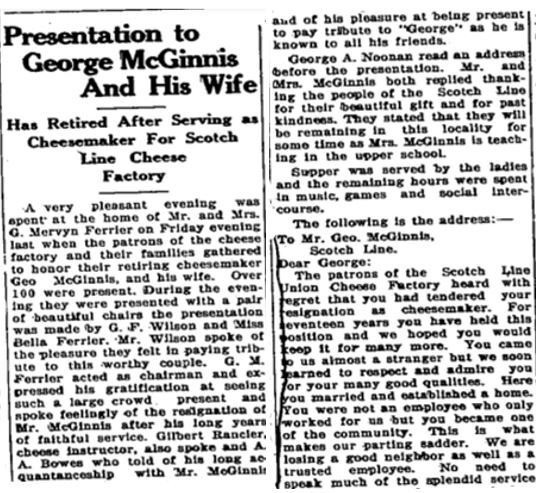

Nov. 20, 1941, p. 2, “The Perth Courier”
November 1965 Fire

“Fire of undetermined cause razed the Scotch Line Union Cheese Factory for an estimated loss of $40,000 Tuesday.
Rural Fire Chief, Arnold Darou and a ten-man crew fought the blaze from 5:30 p.m. until midnight. Saved was the nearby house owned by Clifford Kelford, occupied by the plant’s Cheese Maker, Lewis Kellar, who was away when the outbreak occurred.
Mervyn G. Ferrier, R.R. 3, Perth, Secretary Treasurer of the co-operatively owned factory yesterday consulted with the insurance company which had the plant covered.
“The fire represents a distinct blow to the 30 owner-members of the plant”, he said, “but a small consolation is the fact that the fire did not strike during our busy season.”
The factory normally operates from May until October 31st and had just recently been shut down for the winter.
Mr. Ferrier said the directors had as yet made no decision about rebuilding.
The factory was originally constructed 86 years ago, in 1879, and rebuilt in 1914.
Mr. Ferrier reported that last year’s total production of 130,000 lbs of cheese had been increased 20% this year. This means that this year a total of some 1,400,000 lbs of milk were processed. This year, too, a new can-washer had been acquired.
The enterprise has played an intimate part in the economy of the area, and a complete set of books detailing its history has been kept up to date since inception 13 years after Confederation.
Mr. Ferrier has been Secretary-Treasurer for 24 years. Before him, Charlie Dodds kept the books 21 years and Mr. Ferrier’s father, John, was Secretary Treasurer for the 20 years before that. Cecil Dodds, President, has held that office for 24 years. Vice President is Victor Mackler.
The Scotch Line Union Cheese Factory provided some of the milk which went into Perth’s Mammoth 22,000 lb cheese of bygone age, the world’s largest.
The decreased winter-time flow of milk provided by the owner-members will be shipped to various district dairies. Granted the factory is rebuilt by next May the normal seasonal milk surplus will go to the plant.”
Nov. 11, 1965, p. 1 “The Perth Courier”
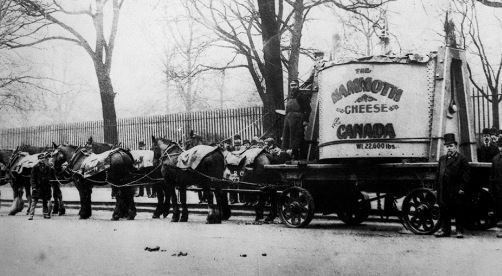
John Wiltsie was Cheese Maker in 1893 when the Mammoth Cheese was produced
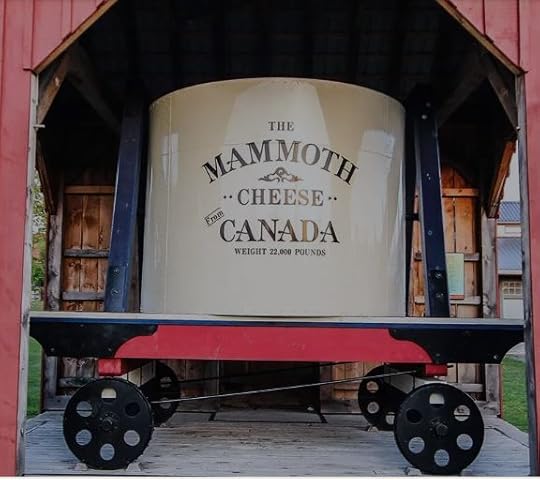
Lanark County’s famous Mammoth Cheese, a 22,000 lb cheese, shown on display in the Tay Basin, next to Crystal Palace.
Twelve area cheese makers donated milk to the project in 1893, for display at the World’s Exposition, to promote Canadian cheese around the world.
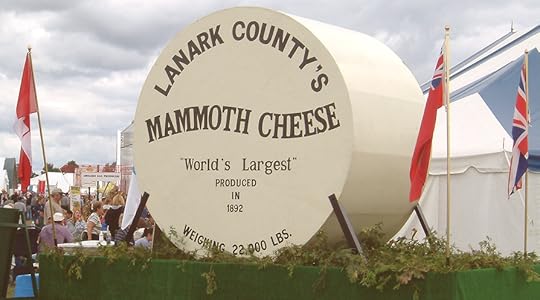
(The site of the Scotch Line Cheese Factory was later the location for Cliff Kelford’s Auto Parts business.)
November 15, 2021
Grey November Skies
It was one of those mornings in the late fall, when the sky was so grey that you couldn’t tell whether it was daylight, or still dark outside. Halloween was over for another year, and the snow hadn’t begun for the season, to remind us that Christmas was coming. It was just one of those four or five dark, grey, lifeless weeks in between the colourful fall, and the bright snowy winter, when Mother Nature didn’t seem to know what to do.

I headed downstairs that Saturday morning, and took a quick look at the clock on the kitchen wall. With the sky so overcast, I couldn’t even guess what time it was, and I didn’t have a clock in my bedroom upstairs. All I knew was the weekend was here, so I didn’t have to go back to Glen Tay School for another two days.
The whole house seemed gloomy. When I got to the bottom of the stairs, and opened the door, the living room was empty. Where was everybody?

The only room that seemed to be lit up in the old house was the kitchen, and as I walked through the living room, and got close enough to see, Mother was in full production, as usual.
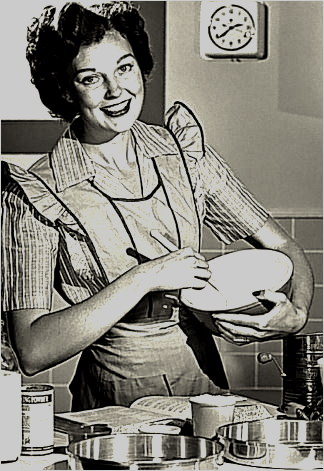
She had the old aluminum meat grinder attached to the kitchen table, and had bags of flour and sugar, and boxes of baking soda and baking powder lined up along the edge.

There were packages of raisins and candied pineapple, and currants and cherries, all over the top of the freezer, as though they were waiting their turn to go into the huge white ceramic mixing bowl. It looked as though some kind of dried fruit was making its way through the meat grinder, and dropping into one of the melamine bowls waiting below.

“Can you run down to Cavanagh’s, and pick up some molasses for me?”, she said without looking up from the meat grinder. “I forgot to pick some up at the IGA last night, and I’ll need some for the Christmas cake.”
“Sure.”, I said, and picked up the three quarters that were already sitting there waiting for me, at the end of the table.

I grabbed my blue corduroy jacket off of the hook, and headed outside. As soon as I opened the door the cold air hit me, and I remembered how the weather had been getting cooler and cooler these past weeks. It felt cold enough to snow, I thought to myself, and I picked up my old, red, battered bike, still lying on the same spot where I’d left it in the yard, the night before.

Brrr. It felt even colder once I was on the bike and moving. The lane was downhill, and I coasted all the way onto the Third Line. I had a quick check for cars, and turned right, still coasting for a bit, then I began to pedal. Ugh, Heney’s dogs!, I thought. I needed a newer, faster bike, or a car, or a spaceship; something to get me past Heney’s faster.
As soon as I saw Conboy’s house, I pedaled like mad. I should have eaten breakfast first, I thought. I could use some energy.
I made it past Heney’s unscathed. They didn’t even come out barking that day. They must have been feeding them or something, I thought. Whew! That was easy.
I was moving pretty fast, and made it to Cavanagh’s in no time. Helen was working, and she pointed out the molasses, and asked how everyone was doing, just like she always did.
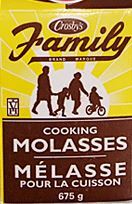
I paid for the molasses, and picked up my bike where I’d left it; propped up against the front entrance of the store.

Since it was Saturday, I decided that I’d take the long way home. I just didn’t feel like riding past Heney’s again and was sure those dogs would be back out on the road, full of food now, and ready to chase me up the Third Line.
I crossed the road and headed up Cameron’s side road. I passed S.S.# 4 school, and was heading up toward Calvin Church.
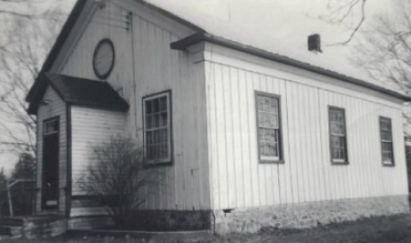
This part of the trip was a bit harder, as it was uphill all the way.

I passed the church, then up the road a bit more, and turned right onto the Fourth Line. It wasn’t long until I was down near Calvin and Marion Jordan’s place, and I slowed down a bit, as I rounded the corner, and headed toward the railroad tracks.

I glanced down into the ditches and spots where I could usually find some flowers to bring home for Mother, but there was no colour in the ditches that day, and even the cattails had gone to seed in the swamp and looked dirty,white and furry. I didn’t see anything worth bringing home for a bouquet.

When I finally arrived back in the yard, I threw down my bike, and walked into the kitchen. I could smell the cake batter as soon as I opened the door. The batter for the Christmas Cake was pinkish. I’m not sure why it was that colour; maybe it was juice from the cherries. Mother had saved the bowl for me to clean, and it was sitting on the edge of the table. Mother said she would add the molasses in with the ground fruit, and that sure worked for me. I loved cleaning out the cake batter bowls. This was my kind of breakfast!

I’m not sure why the Christmas Cake had to be made so early. Mother said it had to ‘ripen’ and I was never really sure what she meant by that. It wasn’t like a green banana, or one of the green apples from back in the orchard. Still, it was part of the process of making the cake each year, and there was no point in arguing.

No matter what the reason for making the Christmas Cake in what seemed like the drabbest, dreariest part of the year, I liked to think of it as kind of a light at the end of a tunnel. It was so grey and colourless outside. The bright leaves were lying, lifeless on the ground. The birds had left the yard. I couldn’t find one bright, pretty flower to bring Mother for a bouquet; not even a cattail. Nature seemed to be in limbo; not sure what to do next.
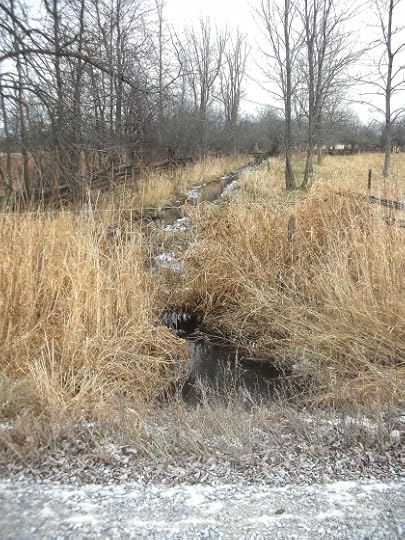
Making the Christmas cake was the first sign that the brightest season of the year was on its way. In just a matter of weeks we’d be celebrating Christmas. Bit by bit, in the days ahead, we’d be making progress on our preparations. The Christmas cards would be signed and addressed. Betty Miller and Frances Dixon would begin organizing the Christmas concert at Calvin Church, and we’d all have our parts to study, and new songs to learn.
Dad would be stringing the Christmas lights on the big spruce tree near the house, any day now. Soon, we would be strolling back into the bush to size up the possible candidates for the Christmas tree, that would grace the corner of our living room.
Before too long, pans of fudge would be prepared, and all sorts of cookies and squares would be baked and stored. Crepe paper streamers would be brought out of storage, and old decorations glued and repaired.
So the grey days, I concluded to myself, were days of preparation. These were the days when we would have time to spend getting ready for Christmas. They were the days when we wouldn’t be distracted by the bright sun, and green grass, to go outside and play, but would stay indoors, and stroke things off of our to-do lists.
In its wisdom, Nature had given us quiet, thoughtful days like these,to focus on the things to come, because Christmas would be upon us in no time at all.
……………………………………………
Granny Rutherford’s Dark Fruit Cake(should be baked a few weeks ahead, and allowed to ripen before Christmas)2 cups raisins
1 1/2 cups of cherries
1 cup currants
1 cup dates
1 1/2 tsp cinnamon
1 1/2 cups seeded raisins
1 cup pecans
1 1/2 cups mixed dried fruit
1/2 cup candied pineapple
1/4 tsp. mace
1/2 tsp. ginger
1/2 tsp nutmeg
1 tsp salt
3 cups flour
1 cup butter
1 1/2 tsp baking powder
1 1/4 cup brown sugar
1/4 tsp cloves
6 eggs
1/2 cup molasses
1/3 cup cold coffee
Mix fruit and nuts (may grind coarse or fine, as desired)
sift flour and spices and mix well
cream butter, and add sugar and eggs
Add dry ingredients
Bake at 300 degrees for 3 – 3 1/2 hours
………..
Allow to cool on baking racks
(double-wrap in plastic, then double-wrap in foil, and store in a cool dry place to ripen)…………
Who was Granny Rutherford?Dorothy Woolsey, born in Lincolnshire, England, was just sixteen years old when her mother Mary-Jane Foster Woolsey, passed away. She often told the story of how they dyed her favourite red coat – black for her mother’s funeral. In 1909 her father, William Woolsey, brought Dorothy and her siblings over to Canada, because his eldest daughter, Edith, had weak lungs, and the doctor advised him the air in Canada would be better for her.
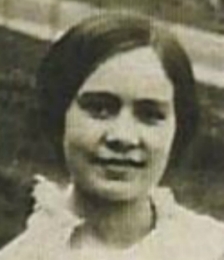
They settled first in Winnipeg, and Dorothy’s older sister Florence, married, and moved to Saskatoon. Dorothy went to visit, and she met a handsome young man named Charles Rutherford, a Mechanical Engineer, who came to Canada from St. Lawrence County, New York, to seek his fortune. Dorothy and Charles fell in love, married, and settled in Edmonton, where their children Dorothea ‘Dolly’, Mildred ‘Mill’, Audry, Muriel, and Jack were born.
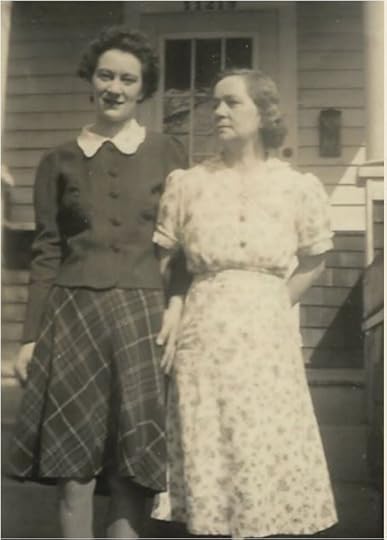
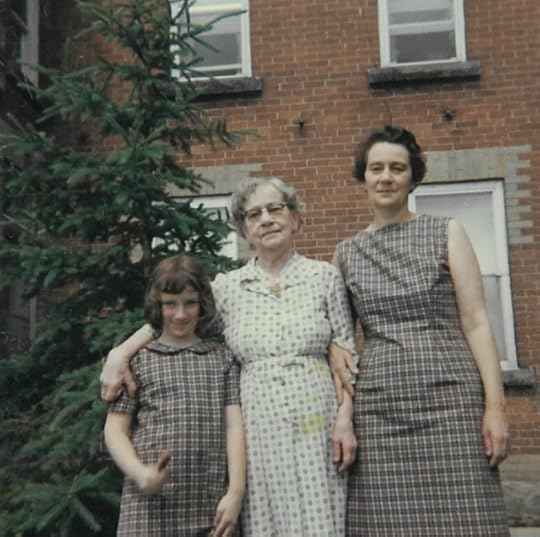
…………………………………………………………………….
Christmas Cake recipe – in “Recipes and Recollections – Treats and Tales From Our Mother’s Kitchen, available in local stores or online. ISBN 978-0-9877026-0-9
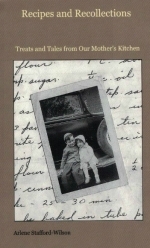
November 12, 2021
Inge-Va Inderwick Estate
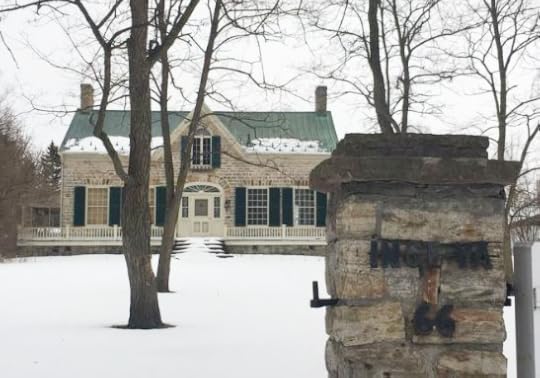
Inge-Va as it appeared in 2018
Inge-Va
Inderwick Estate
At 66 Craig St., in Perth, ON, Built in 1824, of local sandstone.
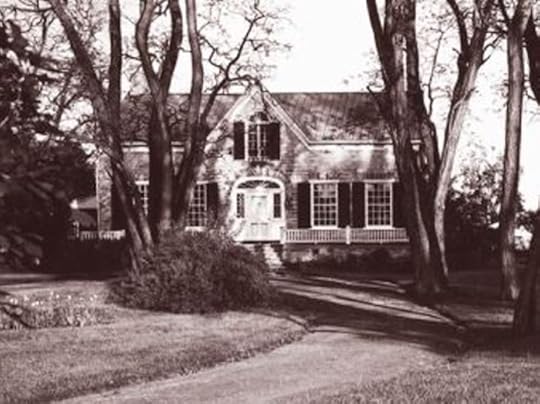
Who were the Owners?
HARRIS family

1824-1839 – Reverend Michael Harris, came to Perth from Dublin, Ireland, in 1819, the first Anglican minister in the district. He was married to Mary Elizabeth Fanning on September 21, 1819. Mary was the daughter of John Fanning and Sarah Wilson. On November 16, 1822, St. James Anglican Church, Perth, opened for their first service, and in 1824, the elegant stone home at 66 Craig Street was built for their family. Michael and Mary Harris had 11 children, Margaret, Mary, Clifton, Caroline, Harriet, Jane, Emma, John, Robert, Dora, and Michael.
In 1839 the house was sold to Perth lawyer, Thomas Radenhurst.
RADENHURST family
1839-1854 -Thomas Mabon Radenhurst, a prominent lawyer, son of Thomas Radenhurst and Ann Campbell; married his cousin Lucy Edith Ridout, daughter of Thomas Ridout of Toronto, and they had four sons and six daughters. He was elected to the Legislative Assemby for Upper Canada in July 1828, as the representative for Carleton County.
Many of Edith’s Children
Died in the House
“She lost three children to tuberculosis, one to typhoid, and one to drowning.“
Edith Radenhurst, was widowed in 1854, at the age of 42, and continued to live in the house. Between 1855 and 1873 she lost three of her 10 children to tuberculosis, one to typhoid and one to drowning. Mary, died age 33, Frances died age 15, Charles died age 27, Edith died age 30, Thomas died age 11, and Catherine died age 26.
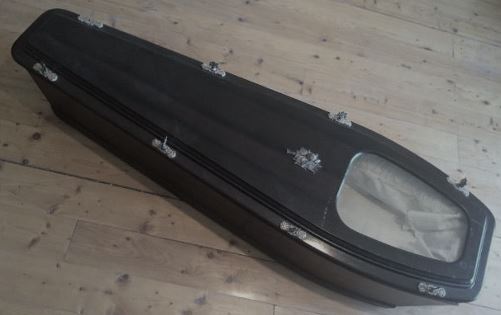
Child’s coffin, of that time
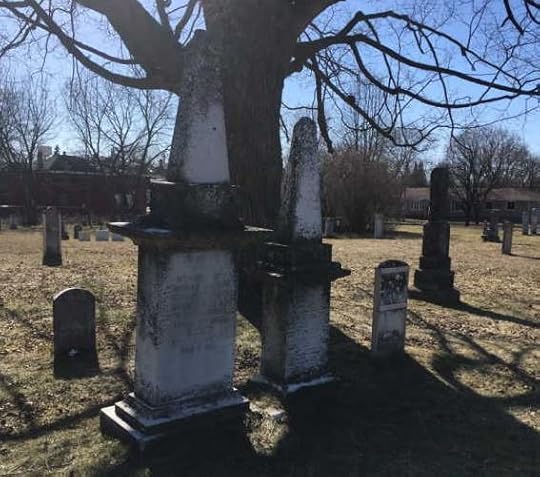
Radenhurst plot, Pioneer Cemetery, Craig Street, Perth, ON
Only four of Edith’s children – George, Anne, William, and Sarah lived into middle age and beyond.
Edith died in 1878, leaving son William, a lawyer, and daughter Annie, to live in the house until 1894. Annie remained single, and moved to Barrie to be closer to her brother, George. William moved his law practice to Toronto.
Archaeologists Discover
Radenhurst Family Dishes
“Thousands of pieces of dishes and kitchenware discovered.”
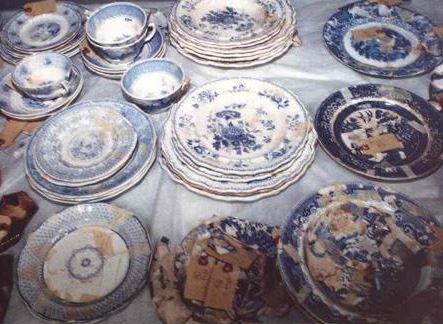
Some of the lovely ornate dishes, glass pieces, and kitchen items were found at Inge-Va
Archaeologists made a remarkable discovery at Inge-Va in 1988. While excavating the site of a small shed which once contained a toilet, they unearthed thousands of pieces of dishes, glasses and kitchenware.
It is believed that Edith Radenhurst had thrown out everything
used to consume meals
because of her children dying of typhoid and tuberculosis.
Last Fatal Duel
Robert Lyon, a close relative of the Radenhurst family was fatally wounded in 1833, in a duel with rival law student John Wilson over the honour of a local teacher. In Perth, it was known infamously as ‘The Last Fatal Duel’. His body lay at the house for the funeral.
In 1894 the estate was sold to the Inderwick family.
INDERWICK family
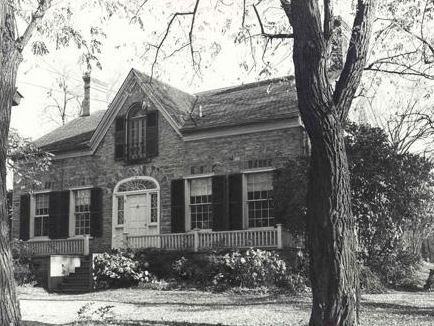
As it appeared in 1923 when the Inderwick family resided there
Ella Leaves Wandering Husband
Brings Children to Perth
1894 – 1989 – Ella Inderwick and her three children: John, Basil, and Cyril, moved into the house in 1894. It was said that she had grown tired of following her wandering husband around the world, in a series of unsuccessful business ventures. Their last stop was her wealthy father-in-law’s tea plantation in Sri Lanka where she often heard the workers in the fields calling out, “Inge-Va”, meaning, ‘Come here’.
“She named the estate Inge-Va
Meaning, “Come Here”
John, the eldest son, moved to England, married Marjorie Handcock, and they had two children – Patrick and Tony. John died in Devon, England at the age of 67. Basil died at the age of 28, fighting with the 17th battalion in WWI, and is buried in England.
Cyril Inderwick, the youngest of the three sons, remained in Perth, joined the Royal Navy, and served in WWI. He lived in the West Indies, and on the west coast of Africa. After WWII, he returned to Perth and married Winnifred ‘Winnie’ Shaw, in 1946, at St. James Anglican church. Winnie was the daughter of Alexander Shaw and Elizabeth Denny. They did not have any children. Cyril became President of the Perth Museum, and was keen on preserving history and specifically heritage buildings. He died at age 67, in 1962.
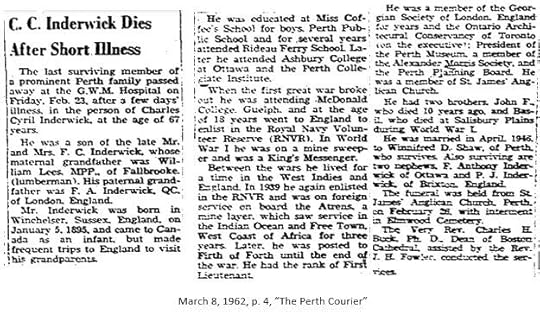
Inge-Va Donated to
Ontario Heritage Trust
Cyril’s wife, Winnifred ‘Winnie’ Shaw Inderwick, local historian and philanthropist, donated the property to the Ontario Heritage Trust in 1974. Through a life-tenancy agreement she remained in the house until her death in 1989.
Ontario Heritage Trust
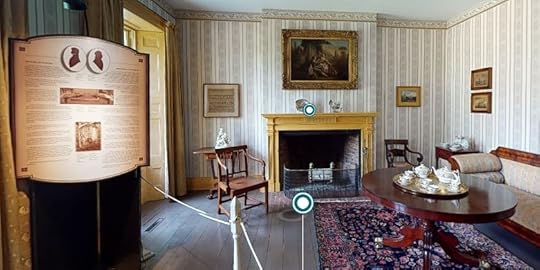
From the Ontario Heritage Trust site – an interactive map of Inge-Va’s rooms
Click on link to take a virtual walking tour through Inge-Va:
https://www.heritagetrust.on.ca/en/properties/inge-va
What Became of Inge-Va?
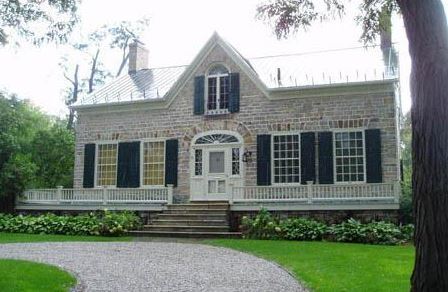
Inge-Va, 66 Craig St., Perth, ON, in 2006
In recent years, the estate appeared to be abandoned, and the grounds overgrown.
In a committee meeting in October 2020, the Perth town council discussed a letter received from a concerned citizen – Lynda Haddon. Haddon stated that Inge-Va was in a dilapidated state.
Together with 16 Perth and district gardening and landscaping volunteers, Haddon maintained and beautified the grounds of Inge-Va in the years between 2004 and 2010. She was also an active member on the house’s Board from 2006 to 2010. The Board attempted to ensure that that there was usually a tenant on site, like the Perth and District Chamber of Commerce, and that the grounds were tidy and buildings were maintained. The Ontario Heritage Trust resumed responsibility for Inge-Va in 2010. Haddon believed that property has gone downhill since then, pointing out that there was no access to the house or the gardens.
Council agreed that Inge-Va appeared to be neglected, and stated that Ontario Heritage Trust is responsible for the property. Council promised to contact Ontario Heritage Trust and said they would investigate further, once they had received a response from Ontario Heritage Trust.
(from the Ottawa Valley News, published Oct. 8, 2020)
In March of 2021, the Perth town council’s voted to sign a one-year agreement with the house’s owner, the Ontario Heritage Trust (OHT), to have volunteers assist in garden restoration at the Craig Street location. The Ontario Heritage Trust promised to provide $2,000 toward the upkeep.
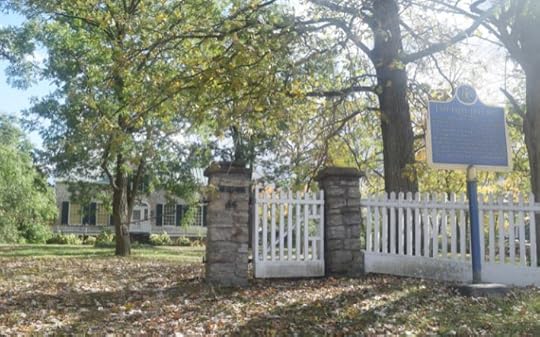
photo: “Inside Ottawa Valley”, “Perth Courier”, Desmond Devoy
Archaeological Treasures
“Inge-Va’s archaeological value is one of its most important characteristics. Excavations carried out from 1987-1994 recovered approximately 50,000 artifacts, 15,000 of which came out of an abandoned privy. This pit contained over 350 china objects and 280 glass objects. Items recovered from the privy include 10 different sets of tableware, 280 bottles, 71 wine glasses, 108 pharmaceutical and toiletry bottles, 16 chamber pots and seven toiletry sets. These items were discarded in an attempt to rid the house of tuberculosis. These objects provide a unique insight into how medical threats were addressed in the latter part of the 19th Century.”
Source: Ontario Heritage Trust Easement Files
(most of these items are being held in Toronto, ON)
Last Fatal Duel
Controversy
Perth Historical Society member, Ron Shaw, has suggested that Inge-Va may not actually be the site of the last fatal duel in the province, as engraved on the plaque, although the body of Robert Lyon is believed to have been carried to Inge-Va for the funeral.
Shaw writes,“an eyewitnesses testified at the Wilson trial, Robert Lyon died where he fell in that North Elmsley Township field,” though Lyon’s body was indeed carried to Inge-Va House, then home of Thomas Mabon Radenhurst (1803-1854), “under whose tutelage Lyon was studying law.”
“(the duel) was fought on the west bank of the Tay River, about 100 yards south of South Street, at a point midway across the width of North Elmsley Township … then the farm of John Ambrose Hume Powell.”
The plaque outside of Inge-Va House on 66 Craig St. states: “Here died the victim of the last fatal duel fought in this province.”
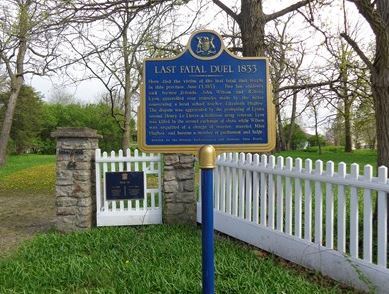
The location of the plaque on the grounds at Inge-Va
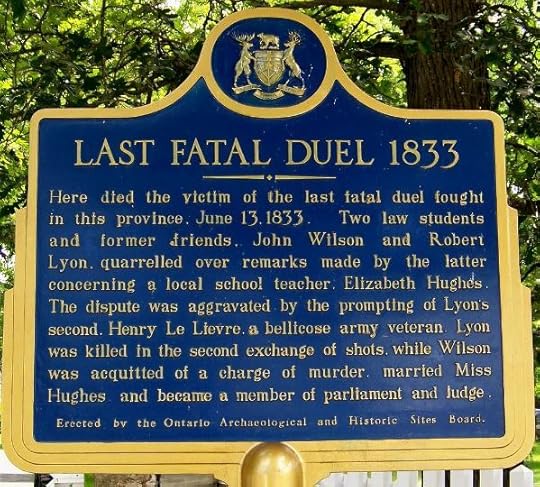
Last Fatal Duel placque at Inge-Va
Source of Last Fatal Duel controversy – ‘The Record News’, Sept. 10, 2021
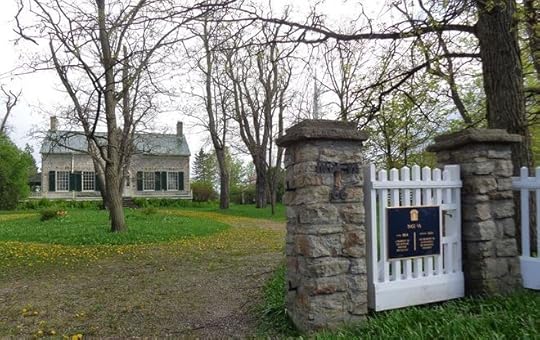
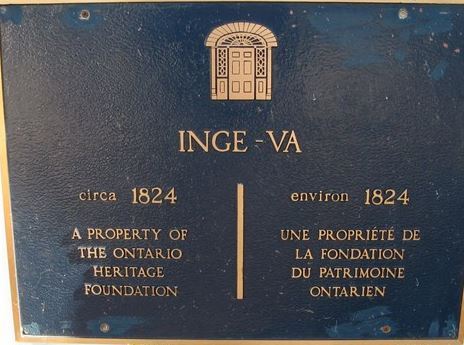
Future of Inge-Va
We can only hope that Inge-Va continues to be valued and treasured by her custodians, and that both the stately house along with the historic grounds are maintained and preserved for future generations.
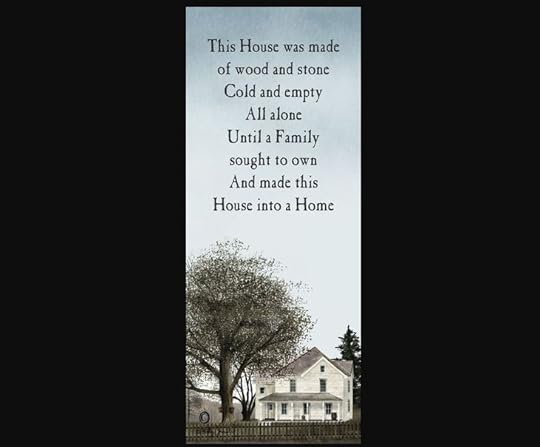
November 11, 2021
Great War Memorial Hospital
Dedicated on Armistice Day, 1924,
in memory of those who fought and died
in WWI (the Great War)
“To remind us of the Great Sacrifice and of our duty, this Hospital is dedicated to the memory of the men of the Town of Perth, and the Townships of Bathurst, Drummond, North Burgess, and North Elmsley, who gave their lives for their King and Country in the Great War of 1914-1918, and whose names are recorded with gratitude and love in the Book of Remembrance placed below, and in honor of their comrades from these municipalities who so gloriously served.”
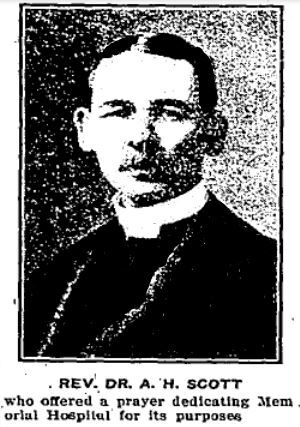
Nov. 14, 1924, p. 3 “The Perth Courier”
To Those Who Gave Their Lives
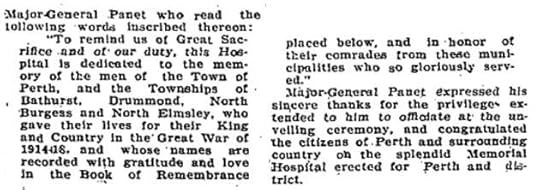
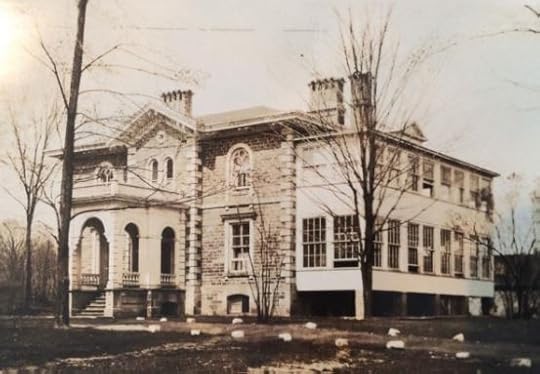
Great War Memorial Hospital – original building, known as Victoria Hall
The Great War Memorial Hospital opened in March of 1923, but the dedication ceremony was not held until Armistice Day in 1924.
Official Opening March 10, 1923

March 9, 1923, p. 1, “The Perth Courier”
Building was the former home of Judge Malloch of Perth, ON

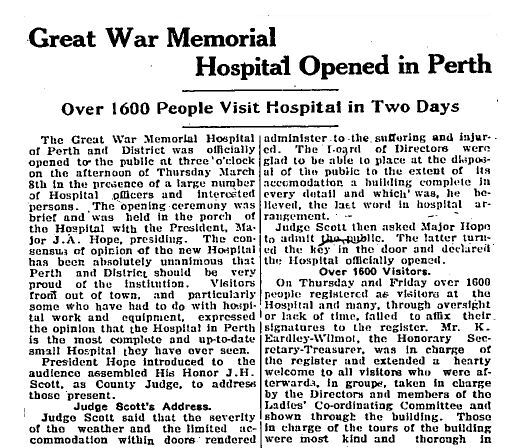
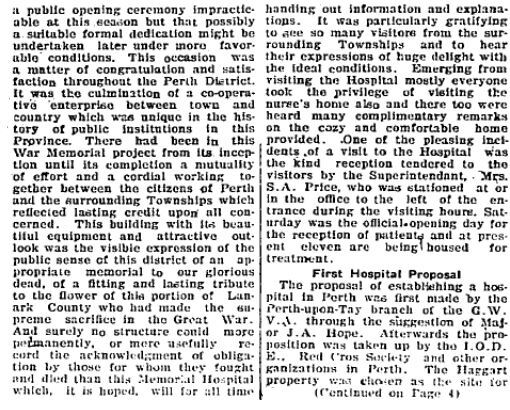
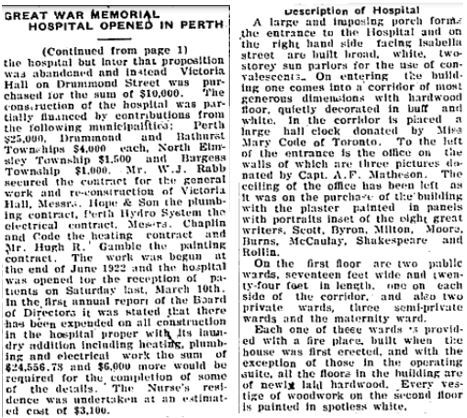
March 16, 1923, p. 1 and 4, “The Perth Courier”
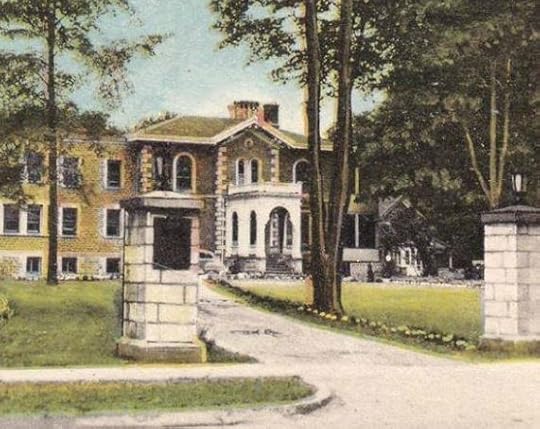
GWM Hospital shown with a later addition to the original structure
The original building, home of Judge Malloch
was said to be one of the finest homes
in all of Eastern Ontario.
Judge Malloch named his home
Victoria Hall

The Dedication Ceremony in 1924
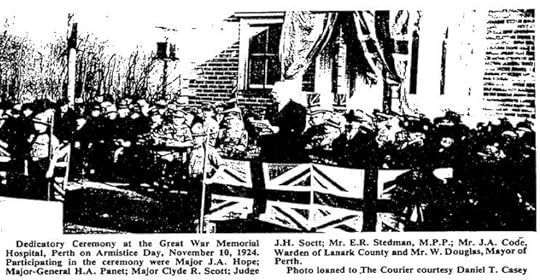
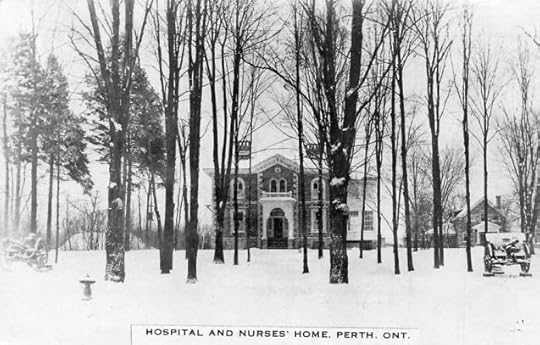
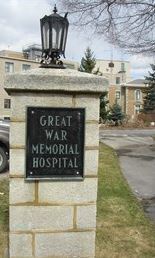
Since it’s grand opening in 1923, and its dedication in 1924, to the soldiers of the Great War, the hospital has provided comfort and care to those in the community who find themselves within its historic walls.
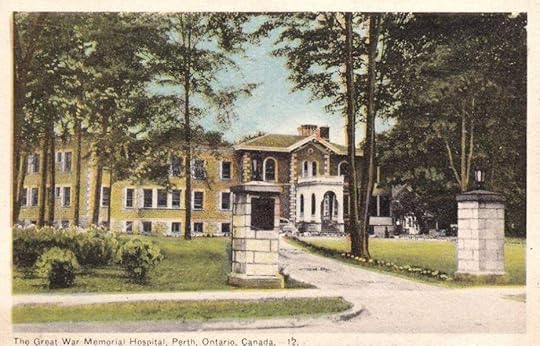
November 10, 2021
A Flag on Her Coffin
She told us many times over the years, that when she died, she wanted a Canadian flag draped on her coffin. She was proud to have served her country, and so, when our Mother passed away, in 2007, we contacted the Legion in Perth, and they were quick to deliver a flag to the visitation room, and place it solemnly over her casket, at the funeral home.
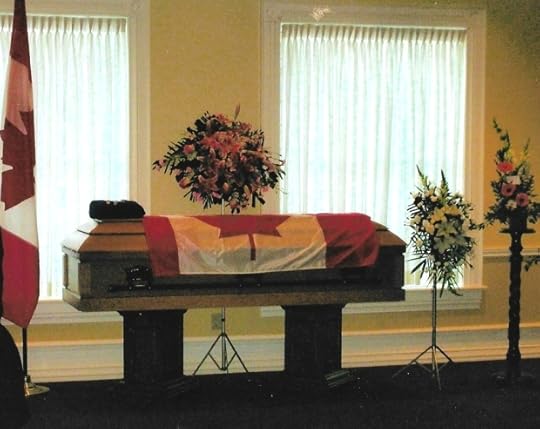
When a dozen Legion members arrived at the funeral home, before the visitation began, they handed each of us a poppy, and requested that we lay them on top of the flag, at the close of their ceremony.
They marched into the room, to the melancholy strains of the bagpipes, fittingly, as our Mother’s ancestors hailed from Roxburghshire, Scotland. The Legion members, all in uniform, proudly wearing their medals, filed by, and paused to greet each one of our family. These were not young soldiers, but many were in the later stages of their lives, and most were veterans of WWII, like our Mother. They were the survivors, who had witnessed many fallen comrades, but through the grace of God had been spared, and had lived, some burdened with dark memories of the war.
Often, at this time of year, I recall Mother’s quiet patriotism. She was, after all, a first generation Canadian. Her father, an American, born along the shores of the St. Lawrence River, in New York State, and her mother hailed from Huddersfield, England, but Mother, born at the Royal Alexandra Hospital in Edmonton, Alberta, was all Canadian.
She never missed an opportunity to vote in an election, and would remind us that battles were fought and lives were lost, so that we could have this privilege. She embraced freedom of speech, and the freedom to choose one’s religion.
After her funeral, the five of us children, went through her things, and picked a few precious items to bring home as keepsakes. I spotted her journal sitting on top of a pile of books, picked it up, and began to flip through the pages. A small tattered piece of paper fell onto the floor. It was an old news clipping, brown and brittle with age, that she had cut out and saved, many years ago. As I began to read it, I realized how much the words summed up our Mother’s beliefs:
IT IS THE SOLDIER– by – Charles M. ProvinceIt is the Soldier, not the minister
Who has given us freedom of religion.
It is the Soldier, not the reporter
Who has given us freedom of the press.
It is the Soldier, not the poet
Who has given us freedom of speech.
It is the Soldier, not the campus organizer
Who has given us freedom to protest.
It is the Soldier, not the lawyer
Who has given us the right to a fair trial.
It is the Soldier, not the politician
Who has given us the right to vote.
It is the Soldier who salutes the flag,
Who serves beneath the flag,
And whose coffin is draped by the flag,
Who allows the protester to burn the flag.
……………………………………….
This story in memory of Cpl. Audry Rutherford (Stafford) R.C.A.F., W.D.………………………………………..


